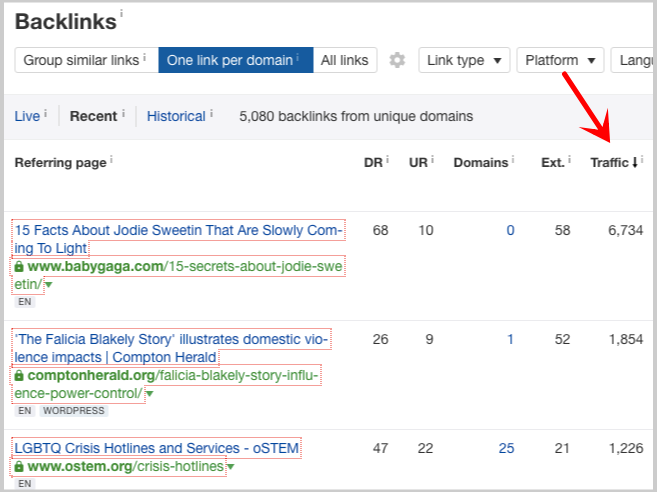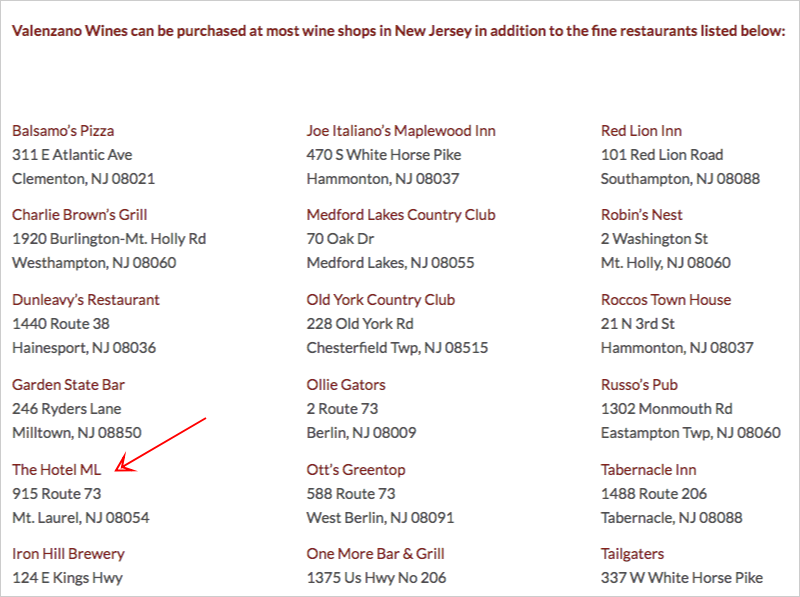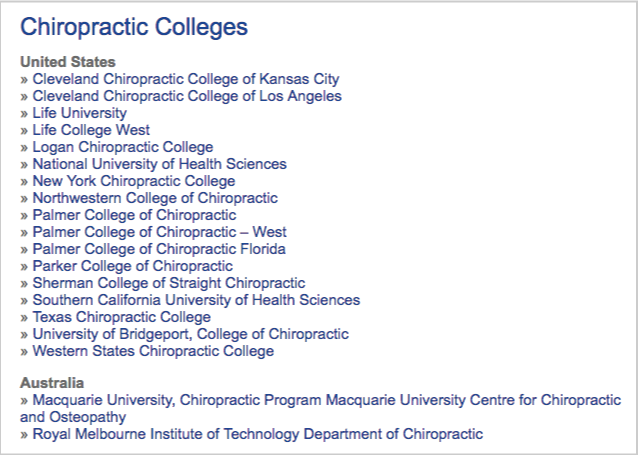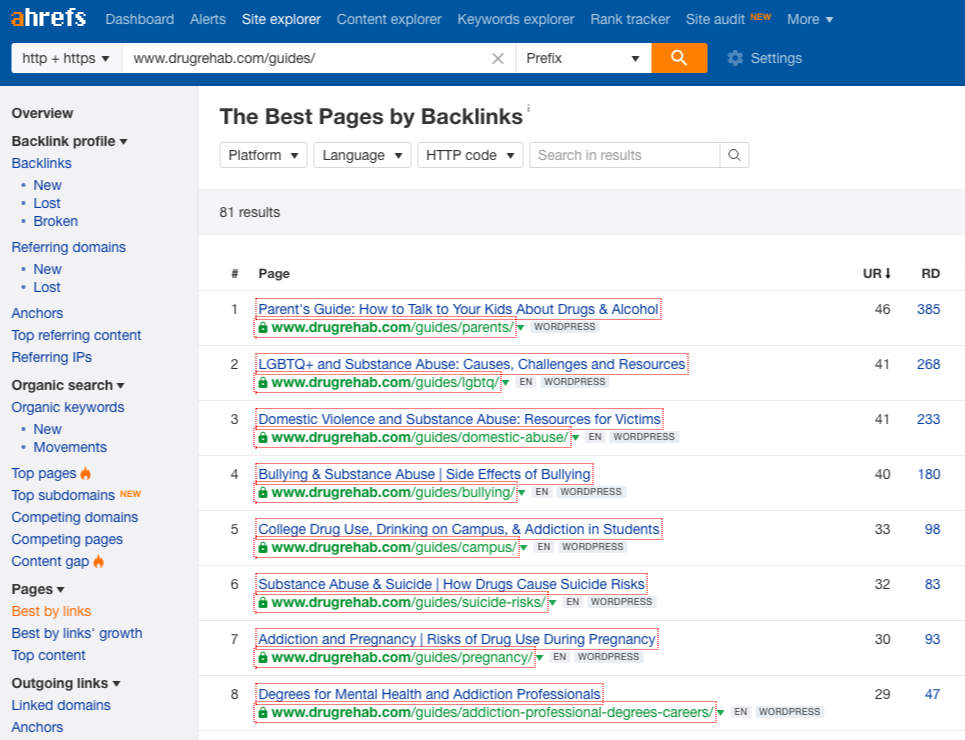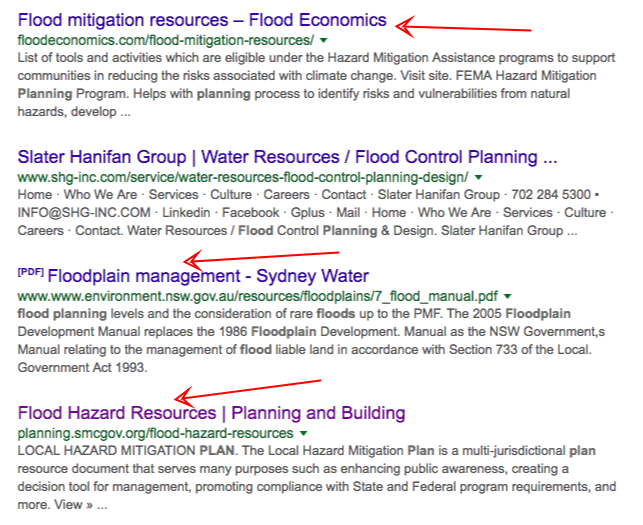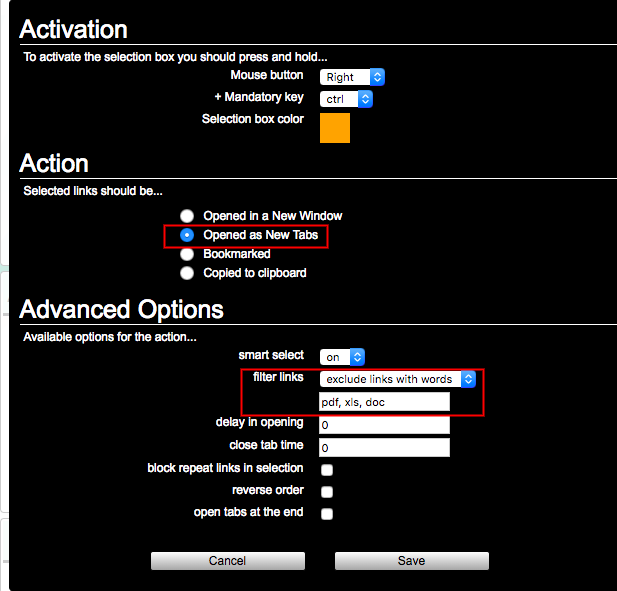How to Find Backlinks Using Free and Paid Methodologies
Learning how to find backlinks shouldn't be too difficult for those people who are starting out in the SEO (link building) industry.
Given that there are proven ways to source pages that you can potentially earn or build links from, you only have to discover these methods, apply it to your own link building campaign and collect a solid list of available link opportunities.
The hardest part is not really finding backlinks, but the actual pursuit of them in outreach. So why give yourself too much difficulty? Get a quick headstart in looking for backlinks.

In this post, we'll cover primary methodologies in finding these backlinks that are easy to use. Follow each process carefully and get the most number of link opportunities in your space.
The Use of Link Building Tools
Just by taking a Google search for the keyphrase, "link building tools", you'll find all sorts of articles that curate quote and quote the best SEO software. Some of these tools are designed just for link building while others aid you with every activity in the SEO process.
Note: You may want to check out my own curation of recommended link building tools.
Going back, what I highly recommended is to check and try out tools that are designed just for link building. The reason behind is that they have the best features, or are best at delivering value in terms of speed, flexibility and results for a certain link building activity.
Let's start with the most-loved link building tool - Ahrefs.
Ahrefs

Ahrefs is one of my go-to product in having a quick look at the best backlinks of a website. Whether it's a website of a competitor, a non-competing blog that produces high-quality content assets for similar topics our client also covers about or just by monitoring similar content production trends of websites from other industries, Ahrefs can provide with a solid view of backlinks.
In finding backlinks, Ahrefs can help in:
1. Viewing the best backlinks of a competitor.
Note: What we refer as competitors are local and/or niche brands or companies you're competing with for a specific offering (either products or services) that have their own websites and maybe are also pursuing organic growth for their business through SEO. If the competitor you know doesn't have its own website, you don't have to consider them as a search competitor.
In a case you don't who are your competitors are, try this out. Do a quick Google search for your primary keyword.
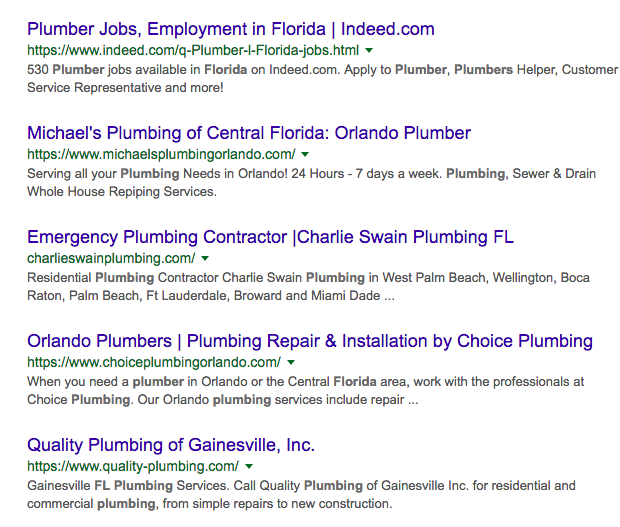
All websites ranking in the first top spots of page 1 are possibly your search direct competitors. Of course, some may just be in a retail business having one page ranking for your target keyword and may not be the exact competitors you're looking for. Other pages maybe a curated list of products/services — so it's very important that you manually check each one of them and see if they are actually direct competitors of your offering.
Another method to find search direct competitors is to use Ahrefs competing domains feature.
Simply enter your domain in Ahrefs' Site Explorer and click Competing Domains. This will give you a rundown of domains competing with your website.
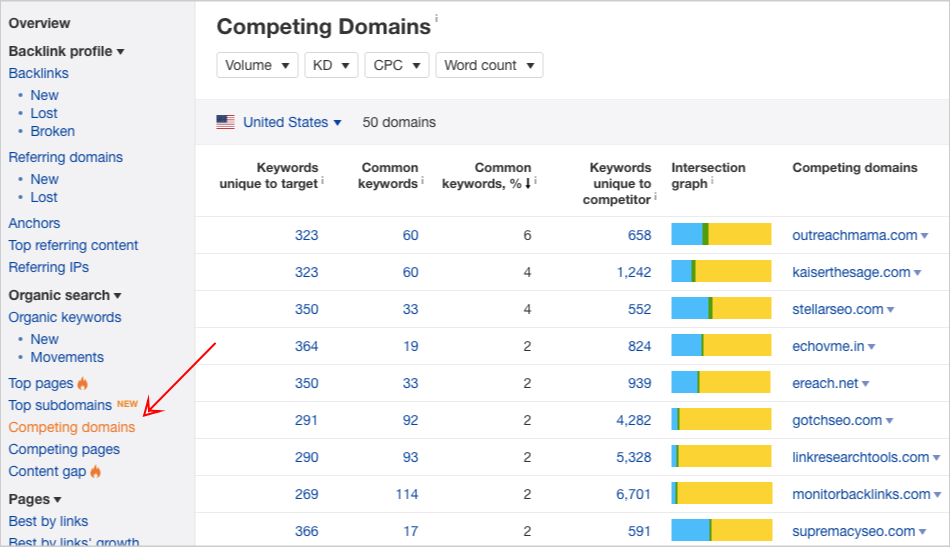
Once you already have a list of competitors, you can follow these steps to view all backlinks of their websites:
- Copy the domain of the website.
- Paste it on the Ahrefs' Site Explorer box for domain URL.
- Click the search button.
- Click on Backlinks under the Backlink profile (located at the upper left section).
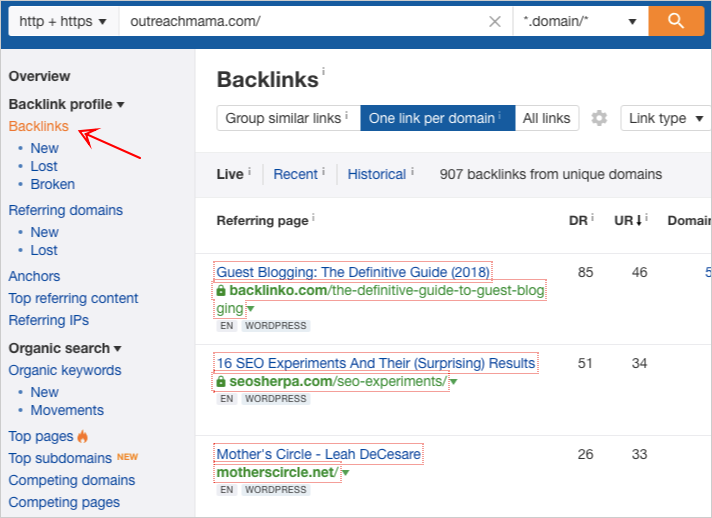
Note: If you are looking for backlinks for a specific page, not the entire website, use the URL option of Ahrefs' Site Explorer. But in the case of a category or blog section, you should choose their Prefix option.
2. Getting the data of backlinks.
Ahrefs provides backlink data, which are components of backlinks that will give you hints of when and how links were built or earned. These data include:
- Referring page (the exact website or page where the links was found)
- Anchor text (the words or phrases that link to a target page)
- Backlink (which page of the website has been linked to)
- First seen or lost (when Ahrefs saw the link)
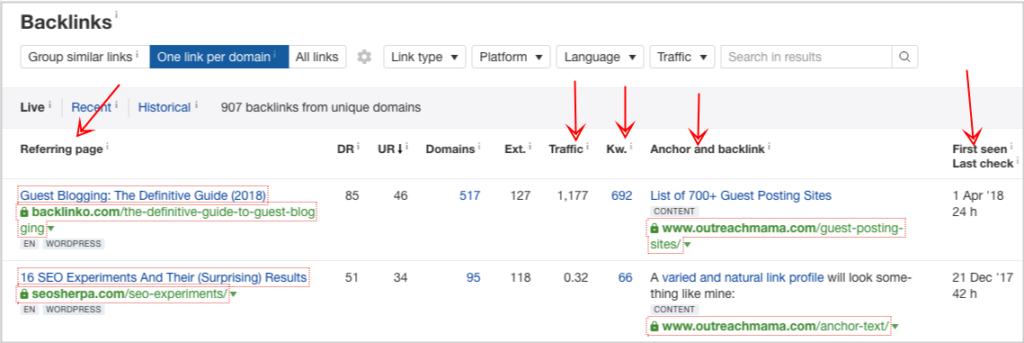
By looking at the first set of backlinks and their respective backlink data, you'll have a preview understanding of how natural backlinks were built.
For example, if you see that most of the top backlinks have branded anchor texts, meaning that the title or brand of the website are the clickable words and of which are pointing to content (informational page) of the website, it might signal that backlink building were naturally or customly made, and not fully manipulated. That's not absolute, but can overall give you an idea of how they approach link building in general.
3. Filtering and sorting backlinks.
Part of finding backlinks is the ability to make high use of you what you've found or collected. In doing that, you need to filter your backlinks. Filtering helps you get the most out of your backlink prospecting, as you'll be able to separate the wheat from the chaff and do so much with your high-quality prospects.
There are different filters you can play with in Ahrefs platform, but filters are based on the purpose of your link building campaign - what type of links are you trying to acquire for your website.
If you are trying to improve search performance of a newly published content on your blog, then do-follow editorial links on blogs is the type of link that will suit you best.
To look for these do-follow editorial links in Ahrefs, choose Dofollow as your Link Type, Blogs in Platform and English for Language.

Another example. If you want to know whose .edu websites are linking to your competitors and understand how they (competitor) got these links, you may use filters Educational as Link Type and English for Language.

Now, you have a list of .edu links you can manually check for further understanding of how you could actually replicate them.
Filtering and sorting backlinks isn't only necessarily to get the desired links for a campaign purpose, but also in generating linkable content ideas.
To find these ideas, instead of going through the Backlink Profile section of Ahrefs, you may move to Pages section and click on either Best by Backlinks or Best by Links' Growth.
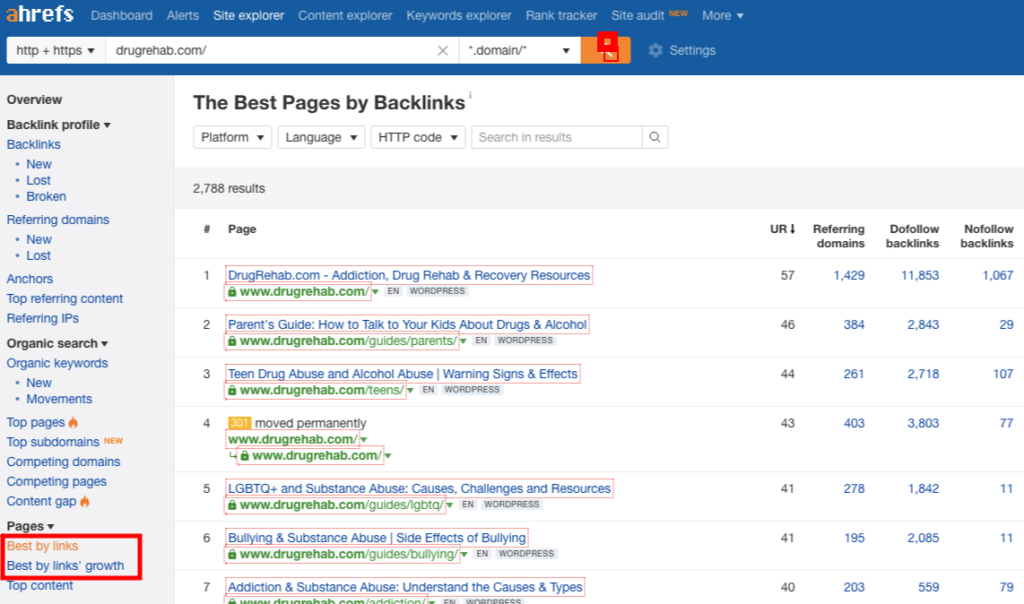
Through those filters, you will see pages that have the most number of links and referring domains. This will serve you well if you're brainstorming for topics for content that have high chances of earning consistent links in your industry.
Pro Tip: You can sort through your backlink prospects from highest to lowest of potential traffic from linking pages (pages where links are seen). This would help you customize your campaign to get links from valuable pages that would also earn links over time - these may drive more visits to your webpages (which will then possibly multiply to another set of links).
4. Understanding how backlinks were formed.
Ahrefs does not only help you view backlinks of a competitor, get the desired backlink data, filter and sort them through to collect the most valuable links. The said tool can also aid in figuring out what approach has been used to facilitate link placements.
For example, if you will know the recent links built to a website, it will lead you to identify some patterns that may occur, i.e. the common page being targeted by these links.
In Ahrefs, you can filter backlinks based on recency (Ahrefs - Backlinks - Recent).

Take a quick scroll and look at the first page of links. It wouldn't take you longer to see common pages being linked to. In my example below, one of the visible linked-to pages is the scholarship page. That may simply imply that the website may have executed a scholarship program recently.
There are a lot of features Ahrefs can be useful for identifying linkable asset ideas and looking for straight backlink sources. Learn best from their regular tutorials, videos and blog.
Further Resources:
Link Prospector
I have been playing massively with Citation Labs' Link Prospector as a source of semi-qualified link prospects for a client of mine recently.
When I say semi-qualified, prospects exported from reports have been run through some tests already. Relevant link type (e.g. links page), relevance and quantifiable metrics, i.e. Domain Authority that are in place can help sort through multiple pages for a search query.
If you want to try out Citation Labs' Link Prospector, I have covered a short tutorial using that tool on this post.
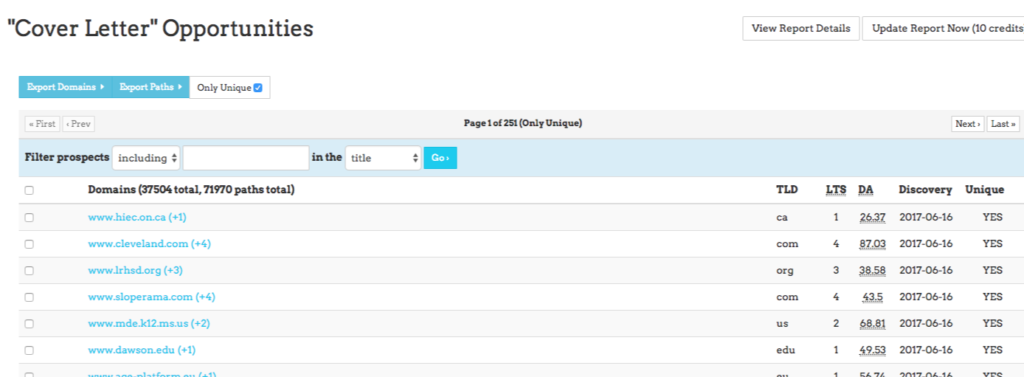
There are other tutorials Garrett and their team have published over the past years, which are extremely helpful to get the most out of it:
- Getting Started With Link Prospector (series of blog posts)
- Citation Labs Youtube Tutorials (video tutorials)
Search Engines
Not everyone has the luxury to subscribe to link building tools, so let's go over how you can use free means to find backlinks in your space.
The best way to start is through the use of search engines.
It's a no brainer thing for SEO professionals to start with this link search method, but I find it strange when agencies complain about expensive link building tools and yet not utilizing search engines for quality link prospecting.
To get the highest usage of search engines, the first discipline one has to master is strictly understanding how advanced search operators work.
A search engine operator is a character or string of characters used in a search engine query to narrow the focus of the search
It would be a huge hit if there is one perfect formula for combining industry phrases with advanced search operators. Far from the reality, there's no one you can find.
However, you can actually customize your entire search query (niche words and appropriate advanced search operators) based on the type of campaign or campaign audience.
Search queries by campaign type
Campaign type is anywhere from guest blogging, resource page link building, sponsorship or .edu link building campaign. The type of the campaign varies depending on the strategy or tactic being executed to get the links.
A search query for guest blogging is different from the one you use for broken link building. Different search queries cater to different kinds of page.
I've created a resource page that lists down all of search queries categorized by campaign types. I recommend that you download the pdf on the search engine queries cheatsheet and use them even whenever you want.
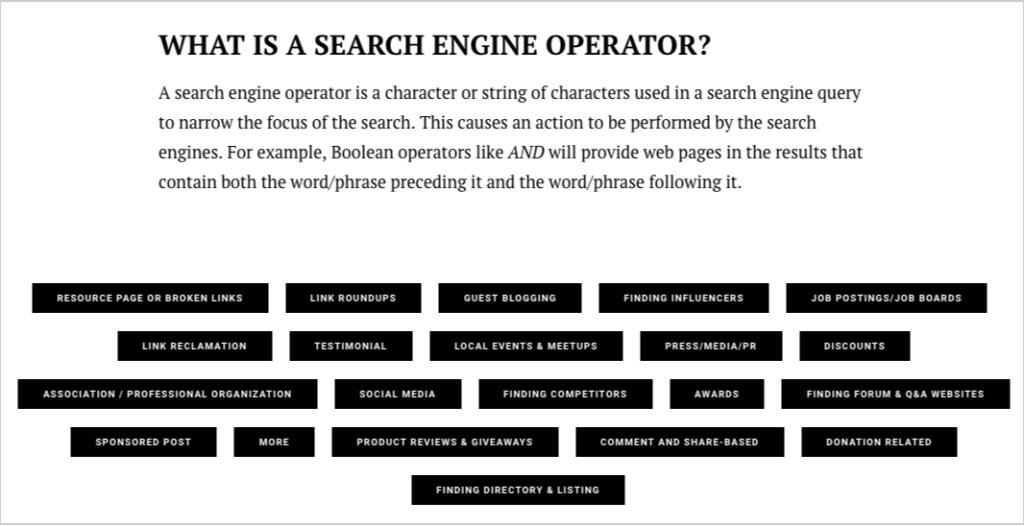
Search queries by campaign audience
By using a combination of inurl and intitle, you can actually target your search to a particular niche audience.
Examples of these search queries are:
- inurl:"for parents" "savings"
- intitle:"for kids" "science"
You may combine your campaign audience with the niche words to populate better search results. This approach is very helpful to refine your search results pages to just the exact pages for an audience within the industry.
Proper usage of patterns in manual link prospecting
Appropriate usage of search queries for a campaign type is a good way to collect your initial list of link prospects. But expanding your list is the challenge. How do you come up with more new prospects if you use the same search query (of a specific campaign type) over and over again.
The key is to understand patterns that can result into multiple of new pages of the same type (or a different link type all throughout) — where if you are curious enough can brainstorm a new link building strategy that you can test out for your website.
To better understand this, let me give you an example.
In my post about link building for car rental companies, I covered a link prospecting strategy that some of you haven't been using for your link search.
It's the method of identifying niche opportunity phrases on pages unique to those verticals.
For instance, in the transportation niche, you'll find pages with "getting there" or "getting here" as resource titles. If you're in a hurry prospecting, you'll miss out those resource titles and use inurl:resources "transportation" instead.
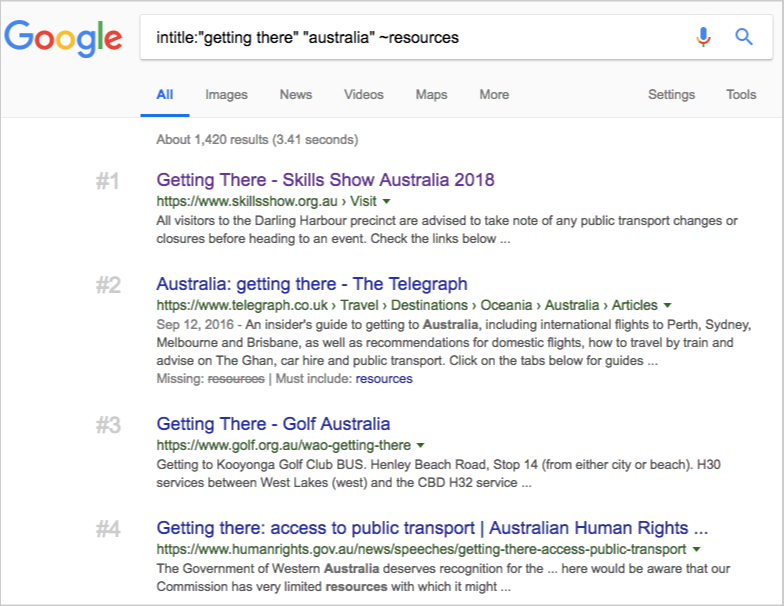
That pattern or footprint is the opportunity phrase itself, which can lead to multiple lists of qualified pages. Combine these phrases to a variety of advanced search operators and you would find a couple more prospects to quality for.
Another pattern you can check on is the specific common url a page has been built. For example, in most .edu sites, library guides pages are resource-like pages they normally publish. The page curates all research, data, news-worthy and other highly-academic content on a topic.
And if you're pursuing resource pages, you may use the exact name URL (libguides) to search for relevant libguides.
The search phrase would now be, inurl:libguides. Combine it with the niche (e.g. psychology) and you'll find libguide pages dedicated to psychology.
Experimenting Search Queries
How to identify patterns and experiment search queries so you can produce more lists than your current list of websites?
First, gather your initial set of qualified pages (qualified meaning they've run through the relevance test yourself). You may prospect them with automation but you have to check those individual link targets manually.
Second, you look for patterns in URL. By URL meaning, you find what are the common words that occur in URLs. Aside from URLs, you may also check each individual qualified prospects. Be curious and ask yourself, do they have similar page titles? How about titles of categories or sections?
Lastly, get all similar phrases in URLs or titles, and experiment by combining them with advanced search operators. Start with inurl and intitle and get the ball rolling.
Using search engines for link prospecting may require mastery in picking up words and understanding advanced search operators. But when you have done it a couple of times, you'll get better at knowing which search query will best produce quality and relevant link prospects.
Track Relationships
Continuing your link search will not be effective if you forget to track all relationships of your brand and your website.
Let's first discuss all your brand's offline relationships.
Offline relationships can later turn into links in the online world. By identifying which of your partners have their own websites and which have the necessary means to be able to link to your site, you'll get better prospecting rate and conversion rate in terms of links.
Apparently, the more your brand is familiar with the person you're reaching out to for a link (most especially if you have established trust and relationship), the likelihood of getting the backlink is much higher.
Let's take a look at retail and manufacturing companies. If you have this type of company (or you're working for this kind), get an inventory of all your suppliers, manufacturers/retaillers, delivery service providers and other partners involved in the operations.
Then check if your partners have their own websites and collect all their contact information (may it be email address or phone number).
That similar strategy can also be applied to eCommerce websites. In fact, I've written different methods to maximize relationships for eCommerce brands in my post on eCommerce link building campaign - you may want to check that out.
Besides offline relationships, there are online connections that have started since the brand's website has started running. These connections may be in the form of editorial, promotional affinities or operational terms. Whatever it may be, it's recommended that you track them yourself and organize all the information in a spreadsheet.
If you don't know where to start, consider these questions: have you written any online columns for a publishing website before? Any online interviews of your founders, editors, or other staff members you remember? Have you worked with a group of affiliate bloggers who promoted your product/service years ago?
Links from Recurring Domains
By identifying online and offline connections, you are on the road of either reclaiming lost links or building new backlinks from recurring referring domains.
Lost backlinks are any links (as implies) lost during a technical issue or discretion of the publisher removing the link from the content (where you originally got the link).
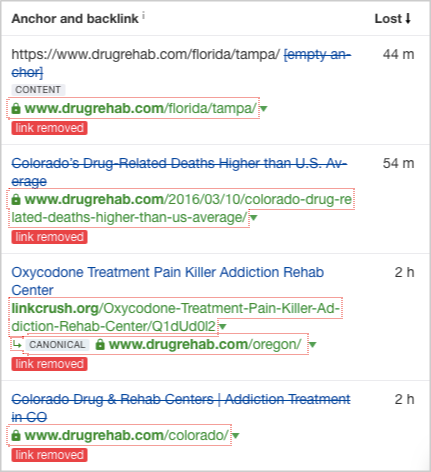
Before sending an email and aggressively tell the webmaster to "could you link again to this page - (your page)", consider these things.
Figure out why your link was removed. Is the page (or even the website) hosting the link was deleted? That is one example of a technical link removal.
If it's not and the hosting page is still live and your link was removed, check if it's the only external backlink ejected. Otherwise, there may be issues with your link (or content) alone.
Review your page/content. Is it off-topic this year? If it's outdated and the linking page requires information to be relevant for current times, it's unwise to reach out to the publisher and get the link back immediately.
That is just one example of how you understand why lost links were removed. It's a caution to first look at the possible reason, see what you can make changes with your content, and make possible corrections.
New backlinks from recurring domains, assuming these sites are authoritatve in your space, are beneficial for your website, as it signals trust and authority — which increase the value of your overall domain.
Get back over websites that have linked to you in the past. And see which are editorial in nature, i.e. links coming from publication websites. If you have contributed an article or column for them, why not reach out again and submit another high-quality content?
All of these shouldn't be done casually but rather make it as a continuous (regular) activity for any new connections that will come along the way.
To help you further, we've created a definitive guide that discusses how to get links through link reclamation - it's a good strategy to maximize value from publications who have used your content in the past.
Secondary Linking Pages
Several pages on the web are interlinked to each other. So, if you have a acquired a link from Page A, it's possible that Page A also acquires a link from another page (Page C). This continues as long as Page C remains to be relevant for linking.
On the first section of this link building guide, we covered how to find backlinks by reverse engineering a competitor's domain. By entering the domain URL in Ahrefs, you can quickly find its backlinks.
You can already get the ball rolling with the first list of backlinks you see in Ahrefs Site Explorer.
But if you want more of highly relevant link opportunities, you may consider secondary linking pages.
Secondary linking pages are pages linking to pages that are linked to you. In other words, they are second-level deep.
In Ahrefs, it's easy to spot on these secondary linking pages. The Domains column can help you figure out the number of unique referring domains linking to a referring page.
For example, I've got a good number of backlinks to this link building website (below is a quick overview of this site's backlink profile).
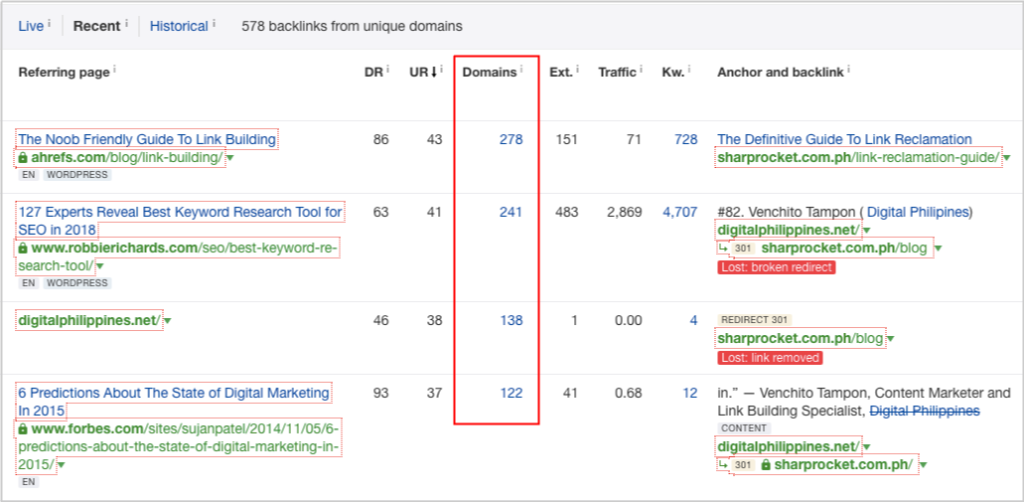
If I want to go deeper and find secondary linking pages, I'd look for the number of Domains column, which as of the time of this writing, Ahrefs as my top linking page has 278 referring domains linking to it.
These 278 referring pages are already second-level deep. If I want to find more backlinks, I'd take a look at them, manually check and see which of these pages are qualified to be additional target blogs for outreach.
Finding secondary pages is a methodology you can execute both for your website and for your competitors' sites. Do it appropriate for your campaign and find more link opportunities.
Testing Out and Doubling on What Works
There is no sure one method of finding backlinks that are good for your site. The reason there are different tools is for you to test them out and see which benefits you the most. Patterns in URLs and titles are also guides to keep you collecting more link opportunities for campaign.
Don't forget, it all comes down to qualifying all your given blogs and websites, whether they come from an export of links using a link building tool, or a manual search through Google or a deep look at secondary pages of a competitor's domain. From whichever source, every potential link opportunity should be checked for quality — so all your next initiatives including outreach activities will be worthwhile.
Need help with your outreach campaigns? Check out our link building services here.
Link Building for Hotels
So far, we have published six link building guides that will help you unlock potential link building ideas for your campaigns. If you haven't seen them yet, you can check out the following links:
- Link Building for Real Estate
- Link Building for Lawyers
- Link Building for Drug Rehab Centers
- Link Building for Fashion
- Link Building for Dentists
- Link Building for .EDU Websites
Today, we'll cover another industry that demands ideas for link building - the hotel industry.
This link building guide is mostly applicable for brands looking to get more visibility on search by properly acquiring links for their hotel SEO campaigns.

Continue reading:
NEARBY OR AREA HOTEL PAGES
If there's one hotel link building technique that doesn't require content to be published in order to get links from other sites, it is, leveraging nearby hotels or area hotels resource pages.
Here's an example of that. As you can see in the image below, it's a resource page that lists down hotels within the location - helping visitors get the exact information of nearby hotels from the page, including the address and their booking contact details.
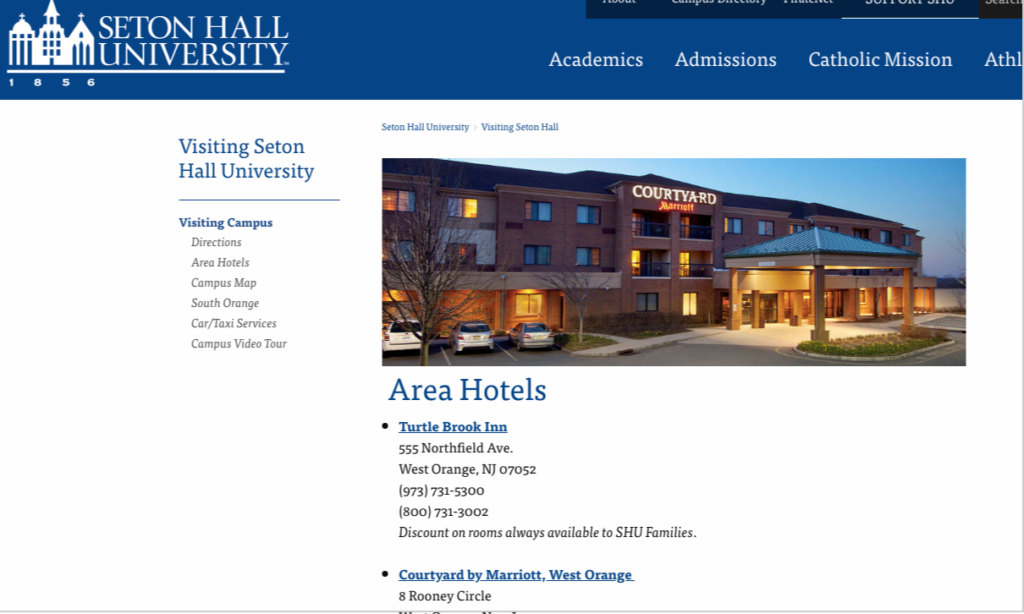
Whether you're in New Jersey, Florida or other cities in the U.S. or in other countries, there are available nearby hotels links pages.
You can do a Google search using any of the following queries to find those link type opportunities:
- site:.edu "nearby hotels" [location]
- "nearby hotels" [location]
- "area hotels" [location]

If offering discounts for customers is part of your marketing campaigns, you can couple your outreach with a customized discount code or any other offerings to get increase the likelihood of getting links from your outreach targets.
PRODUCTS YOU SELL
In your hotels, you normally have restaurants and bar sections or lounges where you sell popular products such as beers or wines.
You may create a list of all of these products or get a product inventory from your hotel brand. Research and see if manufacturers or sellers of your products have their own websites.
You'll find that they have pages dedicated to how to purchase or finding their [product]. These pages include external links or sources of exact stores where products can be bought.
Curators or webmasters of "how to purchase [product ] pages are receptive to outreach of direct partners/retailers, given it's an added value for their visitors looking for specific products.
Find Our Product [Location]
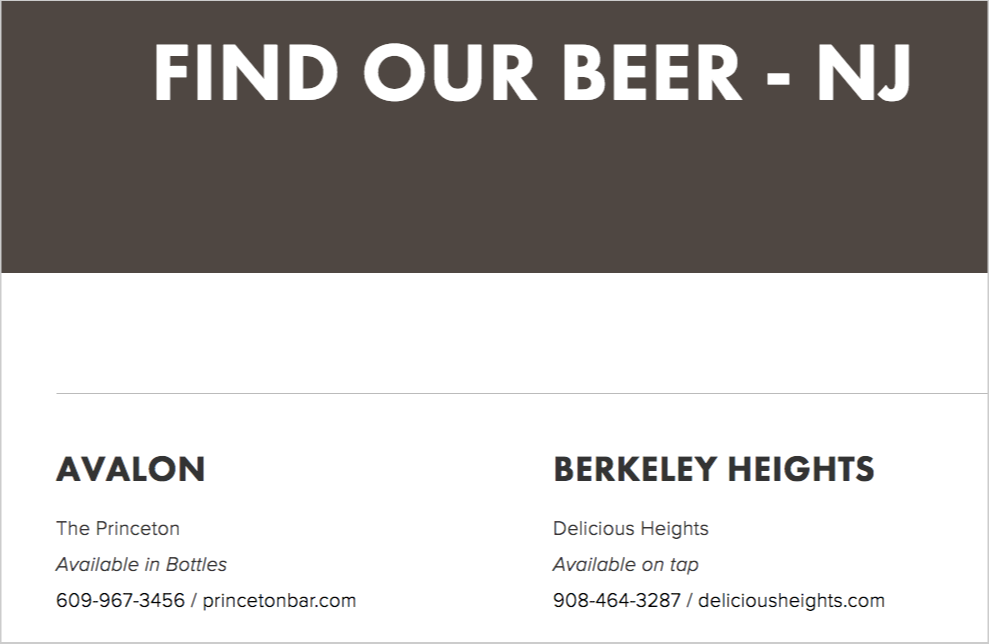
You may use any of these Google search queries to find available how to purchase or find our product pages.
- "how to purchase [product]"
- "find our [product]" [location]
This link building strategy is a low-hanging fruit in acquiring links directly to your bar/restaurant page or to your homepage.
HOTEL DISCOUNTS FOR ALUMNI
Earlier, we discussed giving discounts to nearby hotels page curators. Now let's look at another type of hotel discounts.
If you're doing link building for hotels, it is best to come up with a specific campaign that offers discounts for alumni of universities. There are a handful opportunities of this link type that you can leverage to get not just links, but assisted conversions from visitors clicking your links.
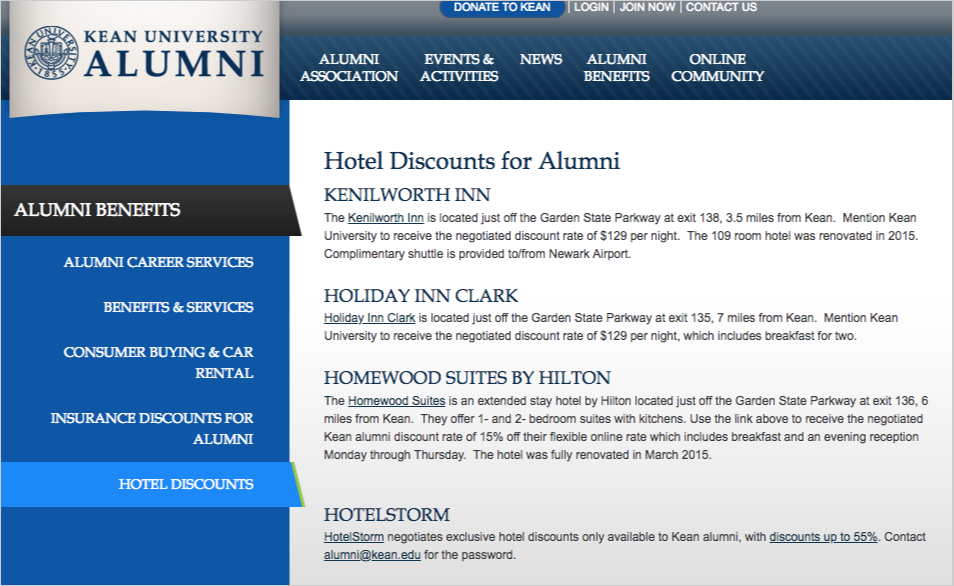
For link prospecting sake, here are useful search queries that will benefit you in finding hundreds of hotel discounts pages (lesser number if you're too specific with your location query):
- site:.edu intitle:"hotel discounts"
- site:.edu "hotel discounts"
- site:.edu "hotel discounts" [location]
You may also localize your link search by targeting hotel alumni discount pages from universities and colleges within your region (check the third Google search query above).
HOTELS AND ACCOMMODATIONS PAGES
Aside from hotel discounts, universities, and colleges also have specific pages just for accommodations.
The page is dedicated for families, friends and guests of students looking for nearby accommodations either for regular or for occasions (e.g. graduation).
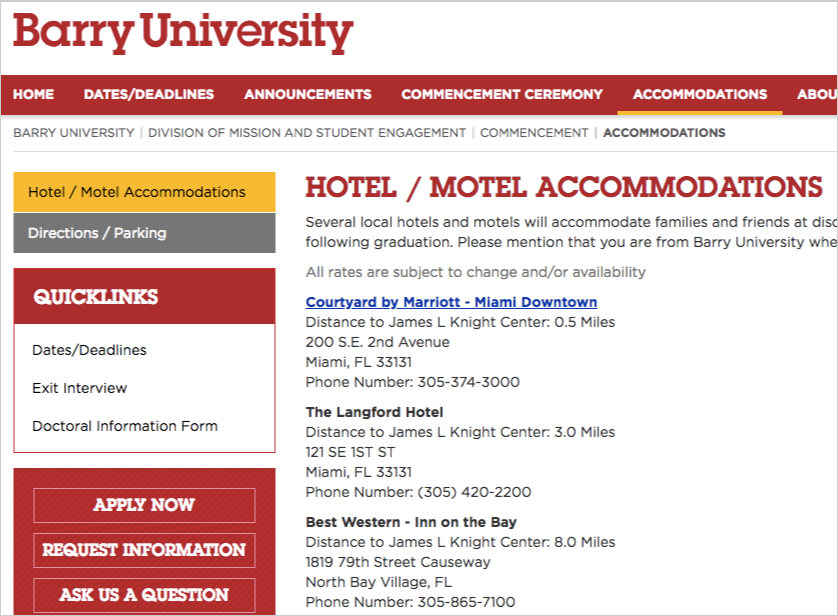
A lot of these pages are easy to find with a couple of search queries in hand. Below are some of them:
- site:.edu intitle:"accommodations" "hotels"
- site:.edu intitle:"accommodations" "hotels" [location]
- site:.edu "accommodations" "hotels"
- site:.edu "accommodations" "hotels" [location]
One note to make is to qualify pages with section or category title of "preferred hotels". Preferred hotels, as implied are ones picked by the university and may not be receptive to outreach that ask for inclusion of hotels without any prior connections with them.
PLAN YOUR VISIT PAGES
Travel enthusiasts want easy guides or simple itineraries for their trips. Therefore, a lot of bloggers and link curators started to create pages just for that - plan your visit pages.
One addition to your hotel website's link building plan is to pursue links from these pages. Those link opportunities also have their own categories for hotels, giving you the confidence that they link out to hotel pages.
You can use any of the following search queries to collect a list of "plan your visit" pages:
- intitle:"plan your visit" "hotels" [location]
- inurl:"plan your visit" "hotels" [location]
- "plan your visit" "hotels" [location]
Location matters for this link type so ensure that you only look out for plan your visit pages that are within region scope of your hotel brand.
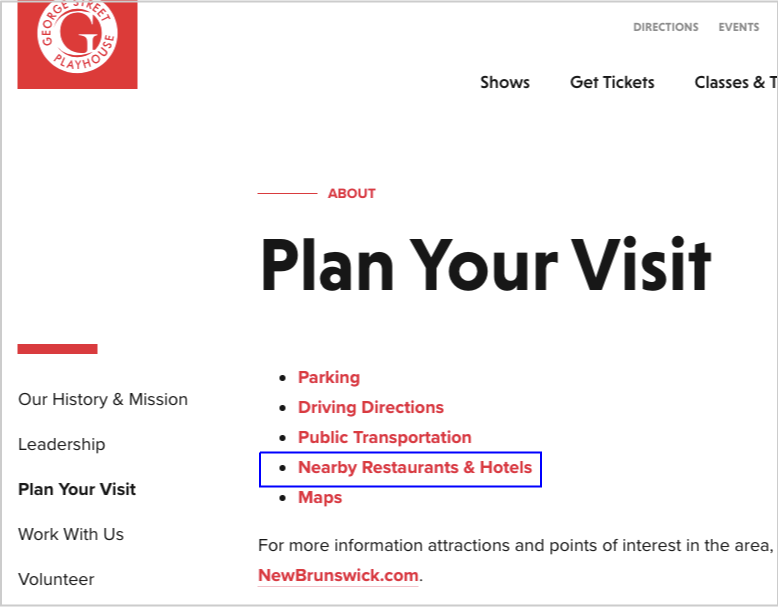
Once you've scoured the search for this type of link target, find your contact persons, and reach out for link inclusion of your hotel pages.
OTHER USEFUL ASSETS:
Let me give you some more link building ideas for your hotel link building campaign.
Attractions - acquire links by contacting local attractions in your region or city. Local attractions like museums, zoos, and theme parks have their own websites that you can get links and potential assisted conversions (visitors looking to book accommodations in your hotel site).
Pet-friendly hotels pages - Does your hotel welcome pets? Be cited on websites like TakeYourPet.com and BringFido.com plus other resource pages that link out to pet-friendly hotels.

Venues in [Location] - if you provide rental offerings for venues during weddings, birthdays, and other occasions, you can search for listing pages that link out to hotels people that have rental venues.
You can use either of these Google search queries: "event vendors" [location] or intitle:"venues in [location]". where [location] should be replaced by your city served by your hotel brand.
Need help with your outreach campaigns? Check out our link building services here.
Link Building for Dentists
If you own a dental website and is struggling to build links for a local dental SEO campaign, this guide is for you.

We'll cover untapped link building ideas for content outreach in the dental field, which interestingly can also be used in other health niche verticals.
Let's start.
LINKABLE CONTENT CREATION
I'll never argue if content is king or queen. What's more important is that you need to publish a content that an audience will link to organically and manually.
In most dental business owners that I talk to and work with, they often wait for organic links. Organic linking or link earning (a common term for it) doesn't have a definite time when and predictable source where other publishers will see your content and link to it.
So if a writer wants to publish a post on "helping your kids overcome their fear on dentists" and is researching for additional references for his post, you hope that he ends up on your page after a Google search and considers your content as a supplementary reference to his future content piece. That's how natural linking works.
On the other hand, when I say manually, you need to do outreach to publishers and link curators and persuade them that your content is good and that it deserves a link. You publish the content but you need to do due diligence to let your audience know of your newest post.
One manual link acquisition strategy for dental clinic websites is creating a solid content that touches an audience ready to link. It's a mission-driven approach in content marketing given that you are serving a particular need of an audience.
For example, one core audience I've seen not all dental blogs tapped onto in content creation is kids. Even if they do, I don't see them promoting their content piece massively to this audience type.

We all know that kids need to overcome their fear of the dentist. You rarely find a kid who is so confident to face his or her tooth doctor. Teaching them about dental cavities will help them overcome fears and enjoy a dental experience.
You can capitalize on that topic by creating a guide for kids and parents to help their children understand dental cavities.
DENTAL CAVITIES
A guide about "Kids Guide to Dental Cavities" is one example of content piece that best suits that.
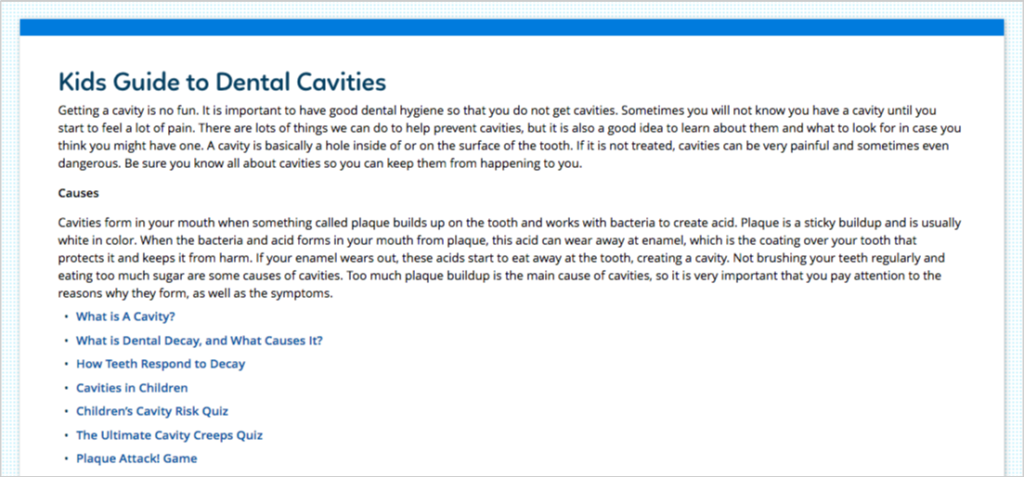
Of course, you won't stop just by creating the content. You need to do manual outreach to promote what you've published.
And you won't start your outreach with prospects on hand. From scratch, you start your campaign by finding suitable link targets.
The right prospects for this specific dental guide are resource pages of elementary websites about kids’ health. These are pages not typically being pitched by link builders and one you'd probably have to take advantage of.
So in order to find them, you can do a Google search for this search query: inurl:sharpschool.com/ "kids health" ~resources.
You may also use these other search queries for Google search:
- "elementary school" kids health ~resources
- intitle:school district "kids health"
- intitle:school district "useful websites for parents"
- intitle:school district useful websites for parents
- inurl:"kids health" ~resources.
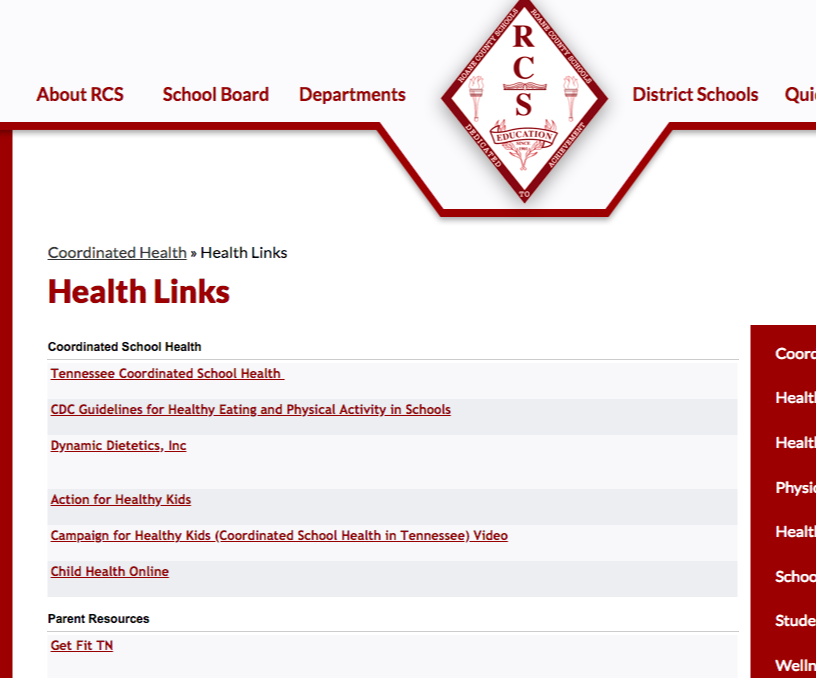
What you will find then is a set of kids health link opportunities that can potentially link to your Kids Guide content.
Your next step is to identify who to contact for each resource page (should be the person who manages or edits the page). Collect their email addresses and execute a proper outreach campaign to get links from them.
DENTAL ANATOMY
Another elementary education guide you can create and publish is a dental anatomy piece.
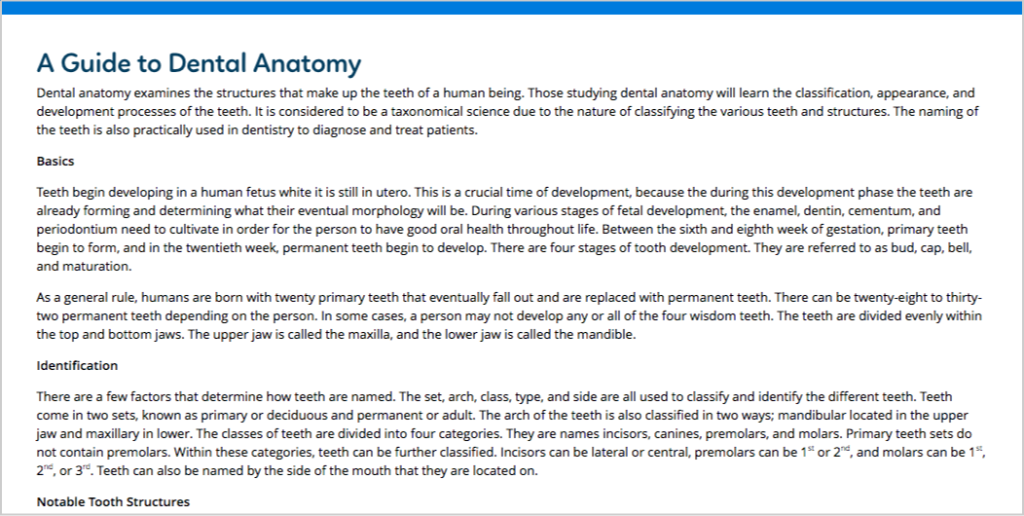
There are several science-based pages for kids waiting to link to anatomy guides.
You can find those link opportunities by doing a Google search for, intitle:fun science sites.
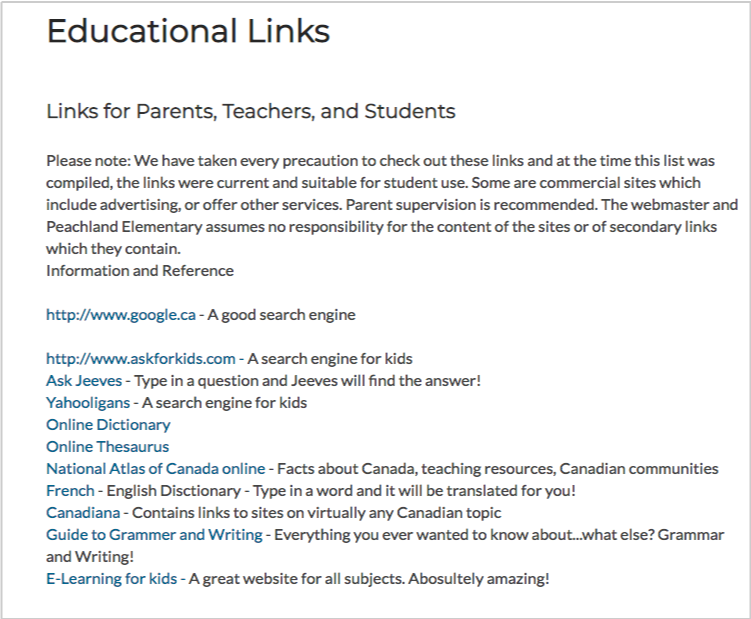

Here are other useful search queries you can also try out for link research:
- intitle:"fun sites" "kids"
- intitle:links educational science kids
- intitle:"kids links" science
- intitle:"educational links"
Similar with Kids guide to dental cavities, you do an outreach for resource page curators.
For our last linkable idea for dentist websites, there is another audience that Brian Dean considers "shoulder niche" - not the specific audience in your industry but is more likely to provide you with links--that audience is anthropologists.
ANTHROPOLOGY
You'll find that there are hundreds, if not thousands of pages about anthropology of any kinds.
So if you can create a historical and comprehensive guide about "Dental Anthropology and Bioarchaeology", it would be another link acquisition campaign you can leverage on.
You can do a Google search using any of the following search queries to find anthropology-specific resource pages:
- "Archaeological Links" ~resources
- intitle:Archaeological Links ~resources
- inurl:links.html "archaeological"

For outreach, below are some several guides that I've written in the past specifically to doing outreach for resource page curators.
Further Resources:
- Conduct Outreach Section of Broken Link Building Guide
- Broken Link Replacements for Better Link Conversion
LEVERAGE LOCAL RELATIONSHIPS
Not all of your link building efforts for dentist websites can be tied to content creation. One link building idea can simply be about maximizing your existing relationships.
I've covered this section on leveraging existing relationships for links in my link building post for drug rehab centers.
But that tactic can also be executed for other niches like dental industry.
Check any of the current relationships you have right now based on the following categories and see which one you can leverage for links.
- local charities you've supported (habitat, religious groups, little league boosters, etc.)
- local business initiatives (tourism & merchant association, "buy local", etc.)
- chamber of commerce and local service organizations
- dental suppliers and manufacturers
I recommend you read this entire guide on building links via existing relationships.
CUSTOMIZED MICRO LINK DEVELOMPENT CAMPAIGNS
This section covers customizing content to different types of pages/sites to get the maximum impact of conversions of links.
Here are some assets you can think of and get to used consistently for your dental clinic website:
- regular columns for top-tier dental or health-related publishers
- local online newspaper
- publications for trade associations
- guest content for parenting websites
- coupon codes for employees and students
One last thing. You may submit your dental business information to dental directories to win some good links at the start.
If you are looking for more link building advice and tips, subscribe to the email optin below to get notified of new posts.
Link Building Ideas for .EDU Website
Identifying your strengths as a brand is critically important in securing backlinks for your website. There are under-utilized resources you have to see and maximize to get the optimal results for your link building campaign

In doing link building for education entities, for example, there are pages that only such kind of website can create. These under-promoted web pages are only waiting to be amplified to its intended audience to gain some more links.
So the question is, "what are these solid pages and how you can best use them to get links to your .edu website?".
Before we reach into the nitty-gritty on how you can build links in the education space. Let's first answer the question.
Do universities hire link builders or do they really need link building for their marketing campaigns?
In our current experience working with a couple of educational institutions and colleges, we've found two reasons why outsourcing to a link building service provider is one of their options to execute a link building campaign for their website.
First, new course programs and offerings need immediate traction.
Though educational entities can resort to paid online marketing means to get eyeballs for their new course offerings, they always look for organic means that will result to long-term effect promotion for their new pages.
Second, educational entity or college produces a lot of link-worthy pages but aren't earning their deserved promotion.
With link building, it's not only pursuing backlinks for the .edu site, but goes beyond than that - additional branding opportunities and maximizing exposure for under-promoted assets.
With the help of new incoming links built from intentional manual link building efforts, it wouldn't be impossible for some pages to rank, earn some links, and receive more exposure.
Now let's discuss pages in an .edu website that are already or could possibly be link-worthy.
1. HOMEPAGE
The homepage of a .edu website is itself a linkable asset, given its nature of being linked to on quotes and mentions on different web sources such as blogs, news, and even curated listings like resource pages.
It is best to setup alerts to monitor regularly any mentions of your brand name. You can identify websites that have mentioned your brand but haven't credited you with links.
Reach out to webmasters of these sites and ask for an appropriate links for your page.
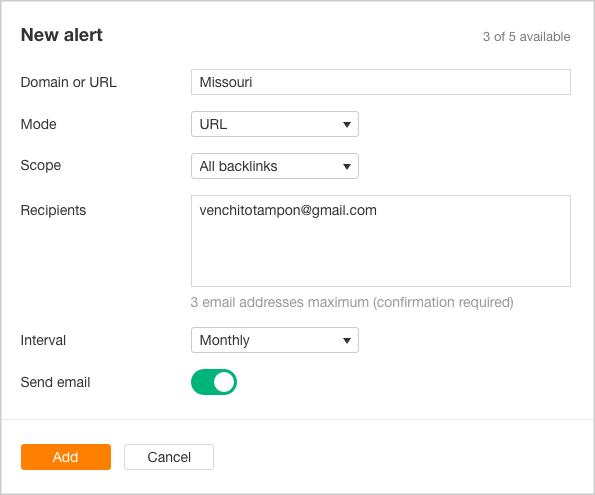
Another way to maximize the authority of a .edu homepage is to find specific resource pages that list down colleges or universities.
I recommend that you start with a macro view of lists pages (i.e. Australian colleges) before going to prospect for geo-specific links pages (e.g. Melbourne colleges).
Here are some key phrases you can use to search for relevant resource pages to get homepage links:
- list [country/city] college
- list [country/city] school
- listing [country/city] i colleges
- listing [country/city] school
- list “[country/city] colleges”
- [country/city] colleges list
- listing [country/city] college
- [country/city] school list
- [country/city] school listing
Reach out to point persons of these curated listings and ask to be included on their pages.
2. SPECIALIZED ONLINE DEGREE PROGRAMS
While you can already build relevant links with the first asset, this second linkable page can give you a more category-specific link equity that can boost your educational degree programs.
The deeper the page is in its category, the more relevant a link should be acquired.
There are a lot of factors that come into play when we build links to online degree programs.
The first one is specialization. How unique your page is can impacts its linkability in outreach. For example, we've had a .edu client who recently offered a "Leadership Master's Degree online program". It is more specialized compared to masters degree programs we all know. That specialization in online degree program allows us to get valuable links from certain pages about a clearly defined topic - leadership in business.
Here are a few examples of niche-specific resource pages for degree programs:

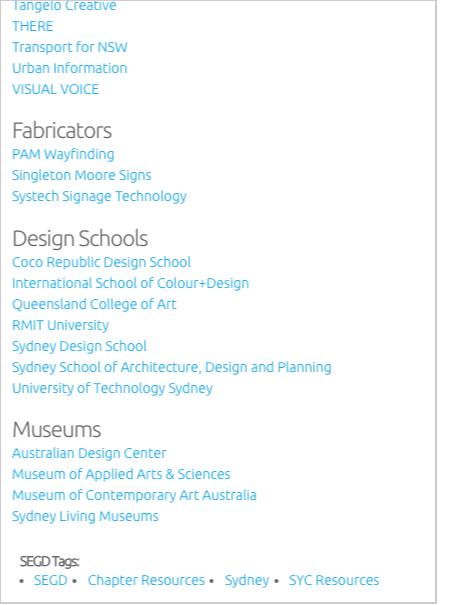


You can find these pages by using any of the following keyphrases (for Google prospecting):
- Engineering degrees in [country/city] list
- listing of ux degrees [country/city]
- inurl:links design degrees [country/city]
Replace niche degrees (engineering/ux/design degrees) with each of the specialized degree programs of your .edu website. By using them for Google search, you'll find a couple of prospects for one degree program and a few for the other pages.
The next step requires groundwork filtering resource pages that match relevance of your degree programs. You won’t get hundreds of pages listing specialized online degree programs all the time, especially if you're targeting country or geo-specific pages. But those few prospects you've found for a specialized degree program are worth pursuing in outreach if you can get just a handful of high-quality links.
3. BLOG LINKS IN THE CAREER SPACE
One of the easiest verticals to gain advantage in link acquisition for .edu websites is career space.
With all of the career blogs publishing job searching articles, there is always a room for very-specific content.
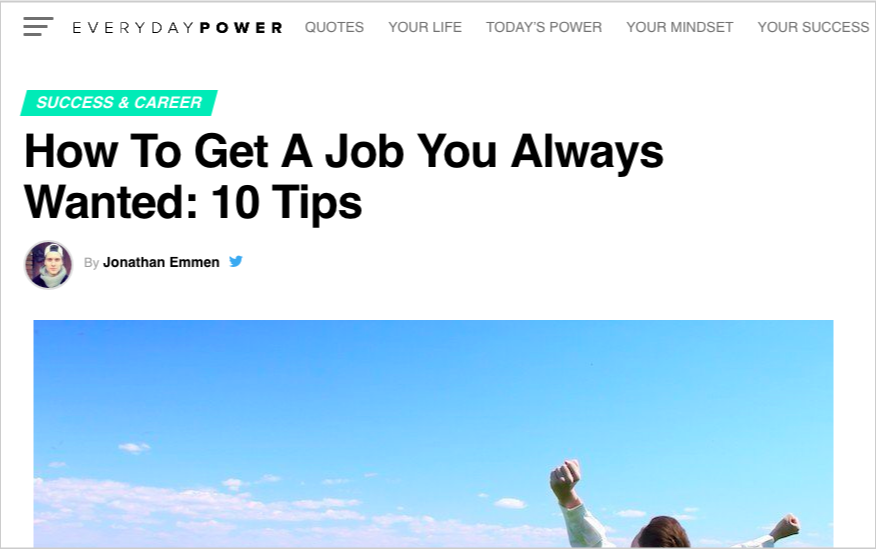
Instead of submitting generic guest post pitches to these career blogs, why not give them a very unique content they haven't published yet? A "how to get a job in [niche]" is a topic they won't hesitate to publish, especially if you have crafted an expert-oriented content on the topic.
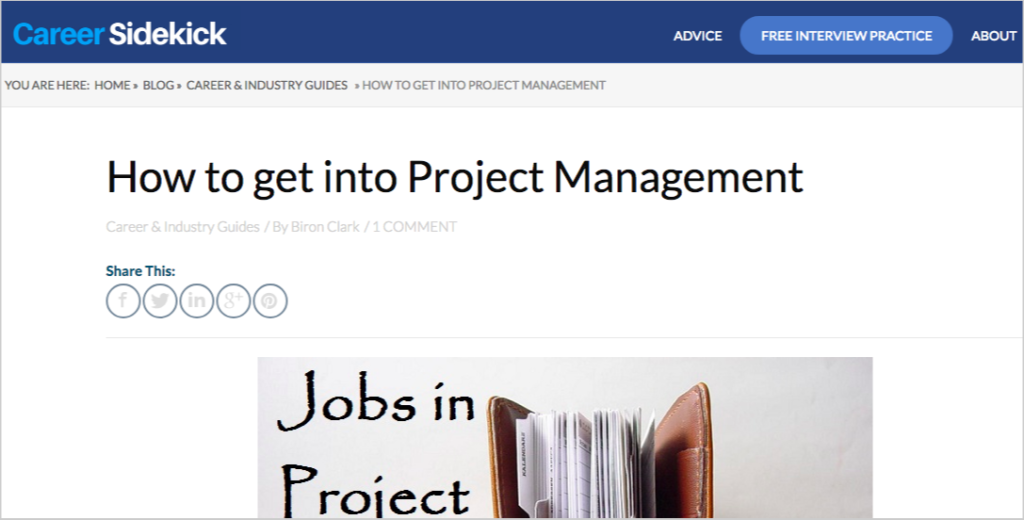
In addition, you can also maximize your guest content in career blogs to acquire contextual links to your sales pages - your online degree programs.
When appropriate in context, those sales external links can justifiably be inserted in guest articles.
Further Reading:
4. APPRENTICESHIPS
When maximizing link opportunities for a given website, you have to identify pages that aren't linkable at the first glance, as it doesn't have any much information to offer. By searching for Inurl:"resources" "TOPIC PAGE", you could be possibly find an opportunity that could result to 10s if not 100s of links.
One example of this type of opportunity are apprenticeship links.
When you have an "apprenticeship" page on your site, try to look for useful resources pages that links out to universities who offers apprenticeship, traineeship and even pre-apprenticeships programs.
A pre-apprenticeship program basically you basic skills in your interest area and readies you for an apprenticeship.
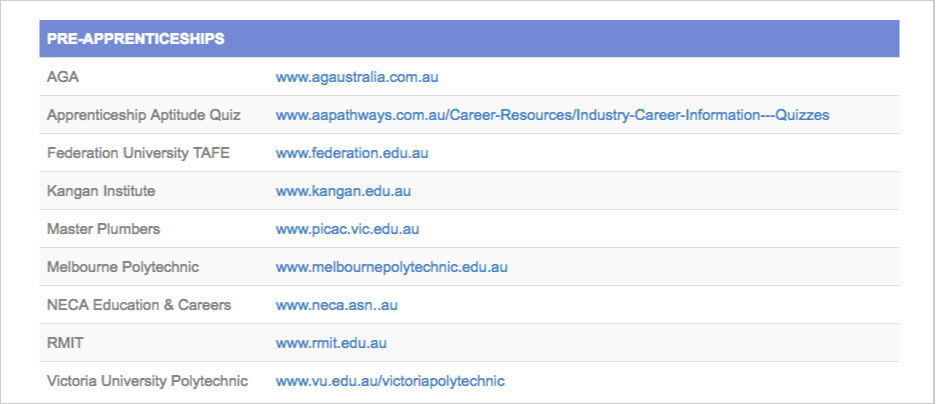
You can do a Google search using any of the following queries:
- "apprenticeship" inurl:links
- "traineeship" inurl:links
- "pre-apprenticeship" inurl:links
Reach out to persons who manage those pages and get your site or apprenticeship page be included.
OTHER USEFUL LINKABLE ASSETS:
Here are just a few pages you could take advantage and explore more link opportunities. One could result to another linkable idea that will help you earn more links to your educational entity.
- Newsworthy events (faculty changes, new building constructions, new program creation and development) International and local awards and certifications of students and teachers
- Literary and academic researches of professors, researchers and other knowledge workers
- Speaking engagements and opportunities
- Student blog section
- Visual assets and how-to guides
- Informative and comprehensive health and wellness, counseling and safety pages
- Library guides sections
- External works (involvement in charities, scholarship opportunities, local and community events, etc..)
Need help with your outreach campaigns? Check out our link building services here.
Securing Backlinks for Drug Rehab Centers
The addiction space is one of the easiest vertical we've found to build links in. With a couple of scalable link building strategies to execute on, you'll be able to generate high-quality backlinks consistently to your site.
Side note: In case you don't own or work with drug rehab centers, I've covered niche-specfiic link acquisition strategy for other industries like fashion, real estate and lawyers.
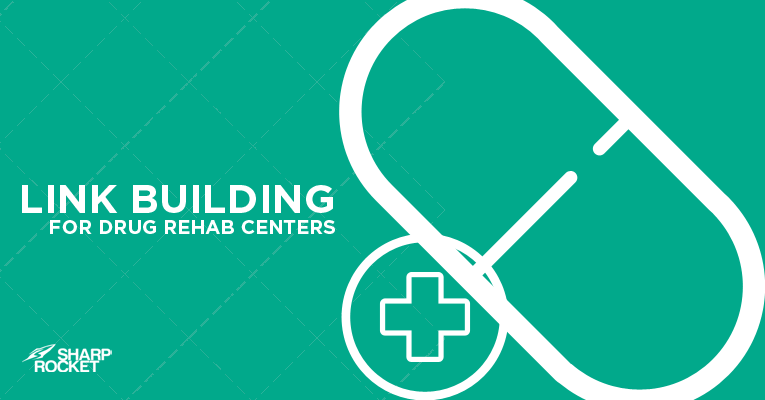
If you're looking to get links to drug rehab center websites, here are link building tips you can play around and maximize for your campaign.
Let's start with low-hanging fruits: relationships.
LEVERAGE EXISTING RELATIONSHIPS
One of the common obstacles in link acquisition is creating rapports with potential link partners who don't have any idea of what your business is all about. Whether you contact them via phone or email, you don't have any control of the possible conversions and the timeframe of actual link placements.
Leveraging existing relationships is one of the most commonly cited but rarely explained link building advice in the local scene. Reaching out to your existing contacts and pleading them "they link to you", will not work.
There are seven easy-to-follow steps to ensure you're getting the most out of your existing relationships:
- Identify who you know who can potentially link to your website
- Determine what kind of online asset will appeal to each individual
- Reach out to every individual about the asset you can provide
- Create the online asset
- Send a compelling email with a clear call-to-action
- Follow up and ensure quality with kind persistence,
- Handwritten thank you card
You can read more of each step in ZipSprout's article on, "Local link building via existing relationships",
It is best to have proper inputs and specific actions for each existing contact. One proper way to do that is to create a spreadsheet to organize them all. Here is a sample spreadsheet from Ziprout.
One example of an existing contact you can leverage with is production events you've partnered with for media purposes.
They have a dedicated page for media partners where they list down and link to each of their media partners.
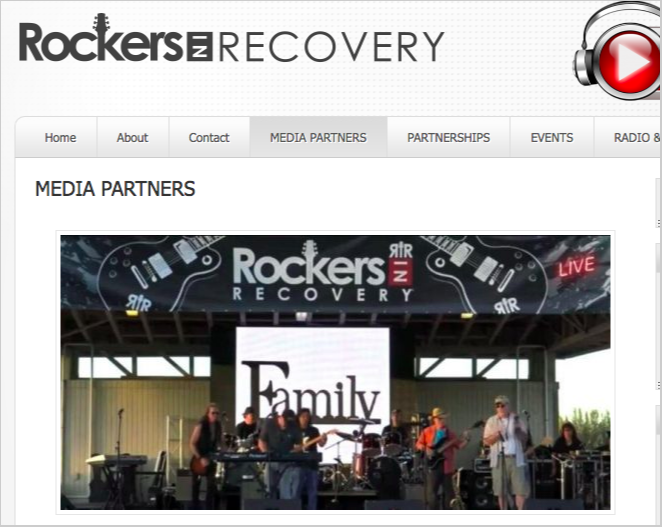
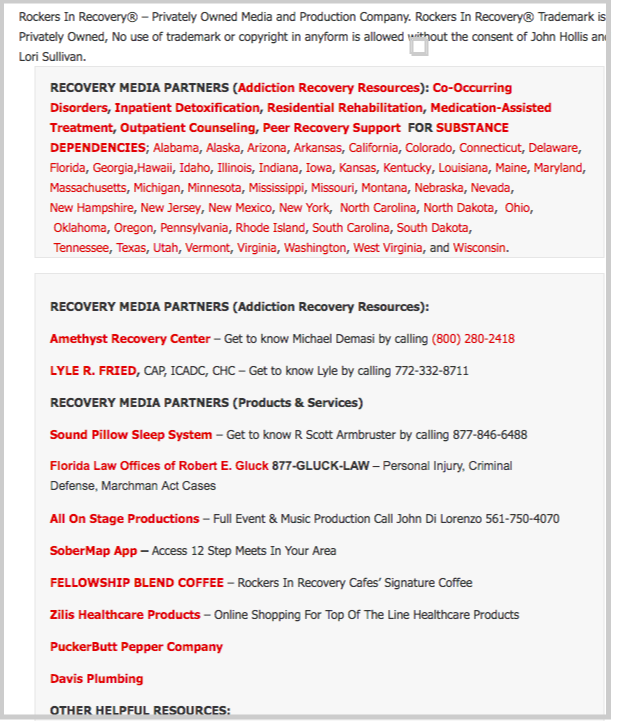
If you've had this kind of partnerships in the past, better to gather their contacts and reach out to them for adding links to your site.
ADDICTION CENTER AND LOCAL BUSINESS LISTINGS
Another two low-hanging fruits in link building for drug rehab centers are submitting business information to local citation sites and getting links from business and local directories.
Both are quick wins in your first-month link acquisition campaign.
Here are websites you can submit business information and/or create business profiles from:
Addiction
Business Profiles
LOW-COST LINK PROSPECTING
We heavily relied on two link sources in collecting resource pages: search engines and Citation Labs Link Prospector.
You'll have to use both methodologies to know which one would yield better results for your link prospecting campaigns.
What I've found is that there are a lot of noises one has to remove in filtering Google search result pages, even if they have used proper advanced search operators and addiction industry keywords.
While in Citation Labs Link Prospector, there is less noise one will be able to avoid by creating a Global Exclusions list to ensure specific websites will automatically be removed in the sourced out lists.

I've shared a step by step process on how to prospect for resource pages using Citation Labs Link Prospector in this broken link building guide.
Pro tip: When running out of best industry phrases or keywords to use for link prospecting, you can use TagCloud to generate new keywords you haven't used for your past link prospecting initiatives.
We input Page Titles of our first set of resource pages (we use Page Titles inputs to customize our email templates in outreach, making it more relevant to end recipients).
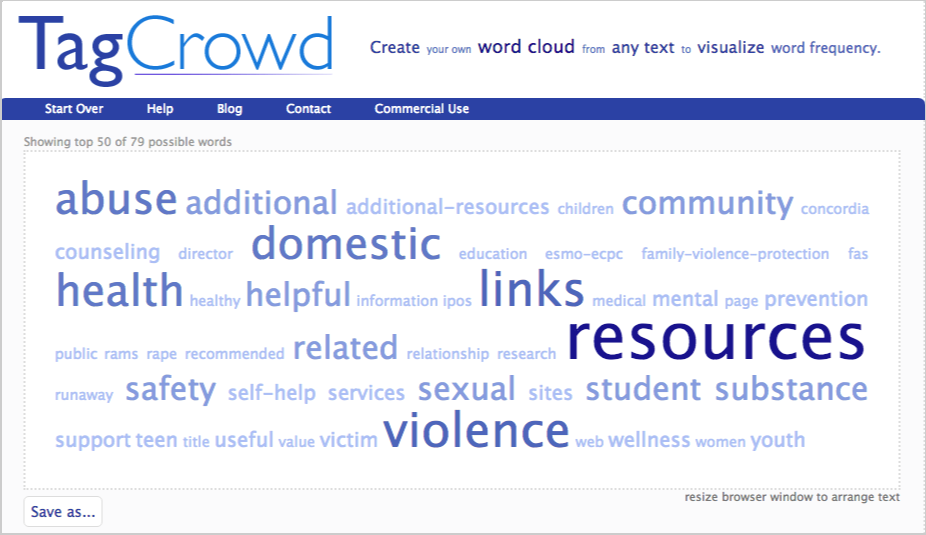
You'll be surprised by how many keywords you can generate using the said approach.
COMPETITOR ANALYSIS
If you're starting from the ground or middle-level, you have to look and analyze how your competitors (from a national or local-centric approach) are creating linkable assets and generating manual or natural links to their sites.
By doing that, you'll be able to see patterns of approaches you can replicate and innovate to even get better results than what they did.
One pattern is a similarity in audiences they're tapping on.
Look at your competitors' top pages and see where most of their inbound links are pointing to. When you scale that to different websites, you'll see a pattern of audiences that they normally target for linkable assets. That's when you can start creating content pieces that have a high likelihood of generating links.
Pro tip: You can analyze on a resources or blog section level to specify top-of-the-funnel pages that are getting links.
CATCH NEW COMPETITORS
As you go along with your search, you'll find new competitors along the way that are still building their brand from scratch. Got a low authority level and is entirely new in the drug rehab industry.
I often dive in to their links and top pages reports to see if they're doing amazing tactics I could replicate to my client's campaign.
Pro tip: If you have landed in a page that links out to different linkable audiences, go a quick link profile analysis on each of the website and see if there are any linkable ideas that could be generated from their linking behavior and patterns.
Need help with your outreach campaigns? Check out our link building services here.
How to Find and Evaluate a Link Building Agency
The demand for high-quality links has grown over the years, as more and more companies see the need for further establishing a solid link acquisition campaign that'll heavily impact their websites' organic traffic performance.
With that burden, doing a specialized marketing in-house will require solid training and execution processes to consistently deliver certain KPIs of links.
Both of these necessitates effort and time to develop, and so, companies of any type or any size, are now looking for a specialized agency to partner with for their link building needs.

If you're looking for a link building agency that will best serve your needs, you need to find them, evaluate and choose one that fits you.
How to Find a Link Building Agency
In general, there are a lot of references and platforms where you can source out a list of agencies to start evaluating.
You can start with these sources to get your list:
- Referrals from partners/companies you've known outsourcing their link building work to others.
- Contributors on top authority sites with highly restricted editorial guidelines (i.e. Moz, SearchEngineLand, Ahrefs), and blog about link building.
- Speakers of local events with mind-blowing presentations on link building.
- Ranking agencies on search engines for keyphrases, "link building company" or "link building services".
You don't need to spend weeks in getting your initial list. The next step is what you should be investing your time in - evaluating a link building agency.
How to Evaluate a Link Building Agency
Assuming you've contacted a potential link building partner and scheduled a call with them, here are inputs you should definitely ask questions about and get answers at the end of your discussion.
1. KPIs (Key Performance Indicators)
It's critically important to know how you can track their performance. Do they both have lagging and leading indicators? Leading indicator is links they produce on a monthly basis while lagging indicator is the search traffic they've generated from content assets they've created.
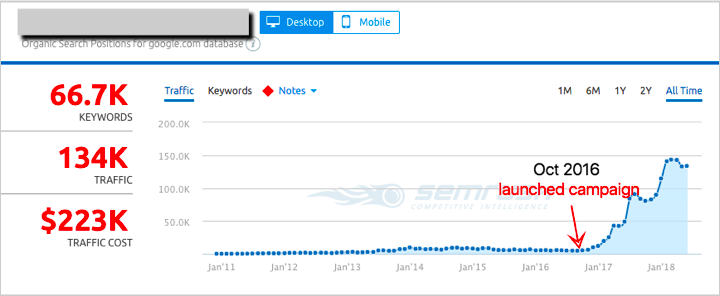
Knowing that allows both of you to set expectations on what to deliver and what kind of report should be presented at the end of each month or project period.
In most cases, you'll find link building agencies whose main offering is a support to the overall full-SEO campaign of a business (which happens generally with SEO agencies outsourcing their link building projects to the firm).
Primarily, those support link building agencies provides deliverables of live links they've acquired for their clients - excluding any reports of organic traffic performance of the website.
Given support link building agencies don't have a full control over the website, specifics to technical SEO and content management, and whose main focus is on external link acquisition (guest publishing, link reclamation and broken link building), you shall expect reports of ONLY links acquired, not the impact of them to organic traffic performance.
The question maybe good to ask is, what's the value of links? If it's not the organic traffic performance that'll be reported, how do you ensure those links will have an impact to your clients or websites?
That leads to second input.
2. Case Studies
Every link building agency should have a document of their case studies.
Link building case studies will help you know they'd helped their past and current clients grow. Though they may not have a full control over the entire full SEO campaign, links they've acquired should have a significant impact to the site's organic traffic.
Ask if they have worked with clients within your sector or in similar markets. This brings familiarity in the market and provide suggestions as to what link building strategy best fits for that and what types of resources are needed to acquire high-quality links.
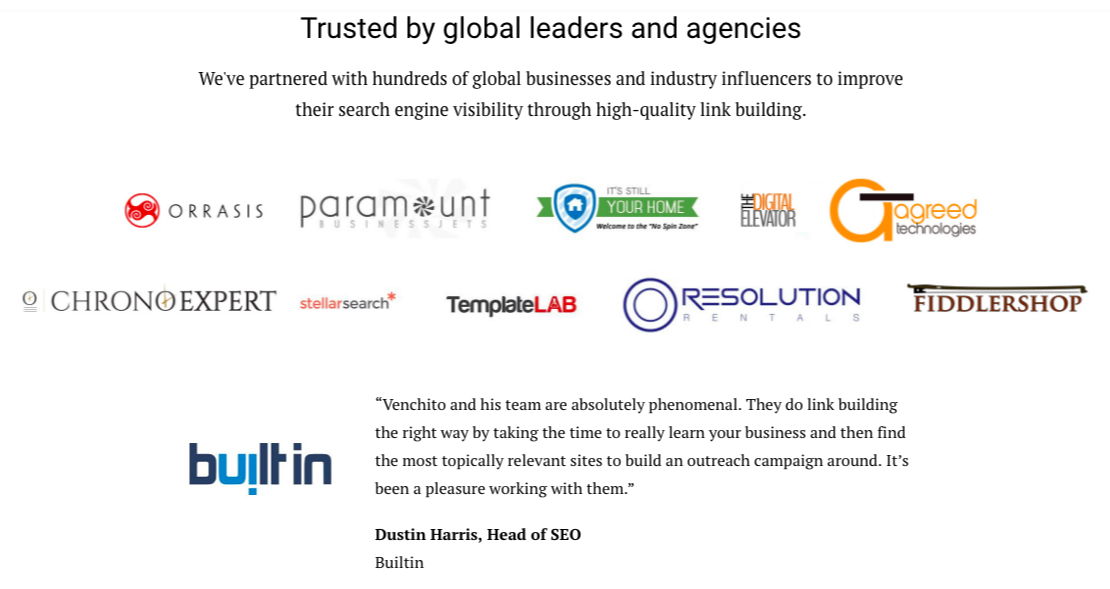
There would of course be agencies who didn't have any link building experience in your market, but you can discern if they are being transparent or trying to just be impressive with awful inputs.
3. Processes, Strategy and Tactics Used
Ask questions about your prospect link building agency's processes, link building strategy and tactics.
Your contact person (sales person, specialist or the agency owner himself) may not fully give you the details, but an overview of how they work, and their strategic recommendations is a big indicator for a successful beginning with your link building campaign.
It is best for you to know by yourself what are the current and effective link building strategies and what types of links that could make an impact to your website's traffic growth. This will help you gauge the ability of your prospect agency to depart from the inefficiency of some link building tactics and low-quality information within the SEO space.
4. Communication
Last but not the least, you shouldn't forget to ask about the contact person you'll get in touch once the partnership begins.
Perhaps, the agency director himself will be your contact person or you'll be assigned with a Project Manager. Whoever it is, that person should directly work with you for most of the following tasks:
- Orientation of the strategy and recommendations to kick-off the campaign
- Discussion on the resources needed from both parties
- Regular updates on the progress of the campaign
- Deliverability of reports or spreadsheets for live links in a given campaign period
There are a few reasons why you should have an idea of the link building agency's communication process:
- To eliminate unnecessary emails due to back and forth discussions with the people who are not involved in the campaign.
- To set clear objectives at the commencement of the campaign and have clear action plans to get there.
- To know what to expect from both parties to get things done
Overall, you want to be looking for an agency who can communicate with you a glimpse of their processes which will increase confidence and build trust to the partnership and will set realistic expectations on the campaign.
John Doherty created a platform that allows you to find a verified agency that aligns with your marketing goals.
If you have questions, feel free to comment below. And you can also follow me on Twitter @venchito14.
LinkHunter Review
Every link management campaign requires the use of tools to facilitate activities in link prospecting, qualification and outreach.
These tools can help scale link building tasks by semi-automating repetitive actions, by filtering domains and pages using certain metrics and by exporting necessary data into spreadsheets (for further filtering and qualification).
In the past, I've reviewed some link building tools, which I highly recommend, Citation Labs and Ahrefs. You can check out my individual reviews about them.
Today, I'll cover another link building tool that I've been testing and using for some of my personal projects.
Introducing LinkHunter…
LinkHunter is one of the recently launched link building tools that is founded by my good friend, Jeff Oxford. He has several years of experience handling eCommerce websites and enterprise brands such as Mastercard and Belkin.
This only ensures that he can effectively cater to a huge market of SEOs by addressing the need for lack of tool's features that'll best help improve effectiveness and efficiency of link building campaigns if integrated to LinkHunter.
Let me show you how the tool works.
After you sign up and sign in to the tool, you can quickly see the overview of your campaigns.
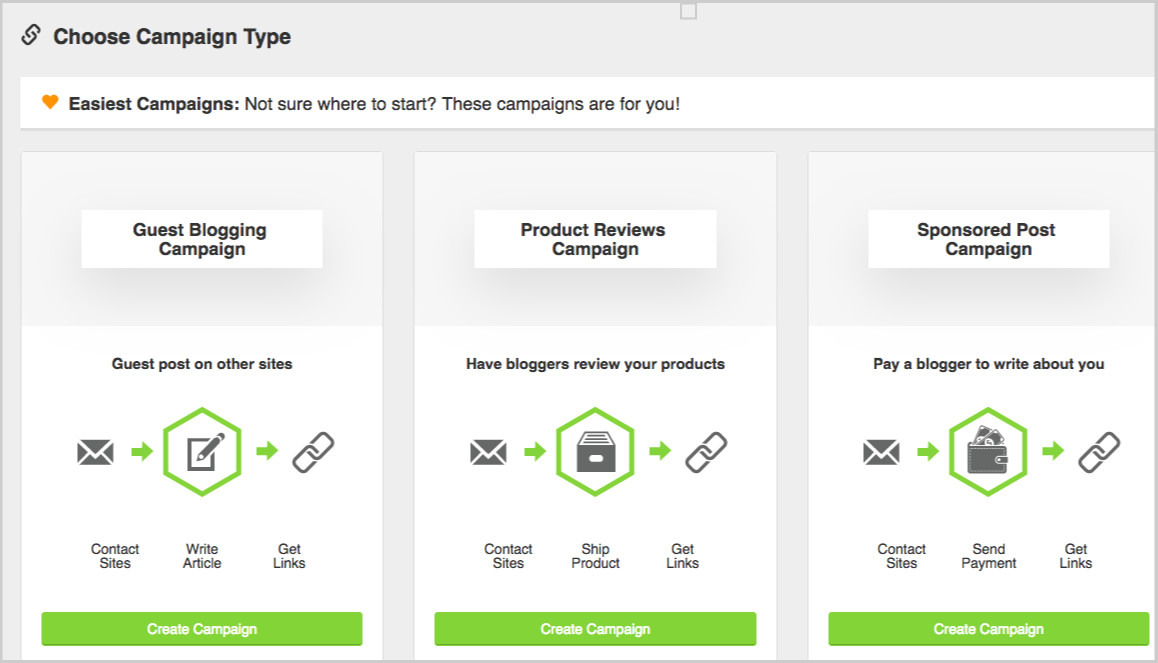
If you intend to create one, there's a button for "Create New Campaign".
You’ll have to choose for three types of campaigns:
- Easiest campaigns (includes guest blogging campaigns, product reviews campaigns and sponsored post campaigns).
- Content promotion (includes blogger outreach campaign, resource page campaign and link roundups campaign).
- Situational campaigns (giveaway campaigns, interviews campaign, podcast campaigns, and custom campaign).
The advantage of this campaign classification is that it allows you to quickly start a campaign based on a specific purpose and types of links you're trying to acquire for your site.
For example, when you want to create a campaign for guest blogging, you simply choose Guest Blogging.
For custom campaigns, you can create one by clicking Create New Campaign.
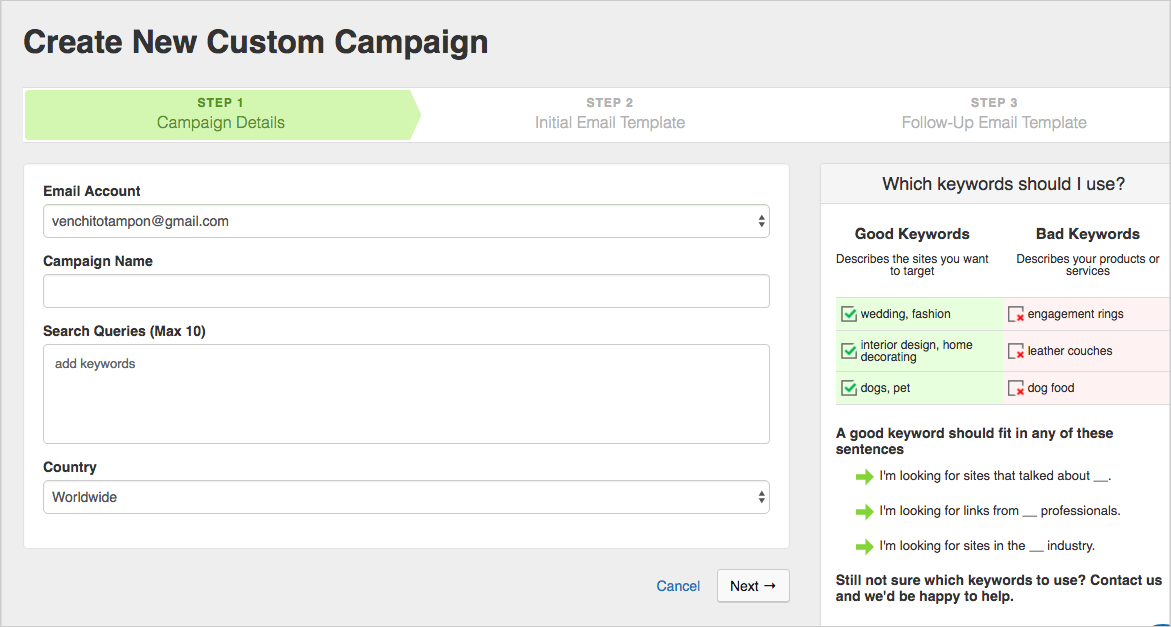
There is also a field for email account usage. It is best to integrate your email accounts (outreach emails) right at the very start so you can easily choose from the drop-down menu of email accounts when you started with the campaign.
If you wish to add your email outreach account, click on "Add Email Account".

Going back from the new custom campaign, you have to input the name of your campaign (better if it's a client name or code you create just for that website).
Next is the link prospecting platform of LinkHunter.
One of the best features of LinkHunter is their "Automated Link Prospector". This is not the exact name of the feature, but for this review’s sake, let me label it that way.
You have to input keywords that are relevant to your website and campaigns. On the right side of the platform, there's a quick guide that shows which keywords are good or bad to use.
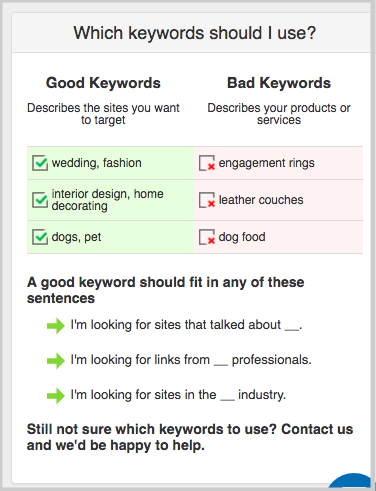
You can then choose the country of search. The tool will basically filter the search pages into the country that you prefer. By default, it's worldwide, but if you're prospecting for country-specific websites, you can choose the right country.
LinkHunter provides free outreach templates for each campaign type which is a big help for those who're new to outreach activities.
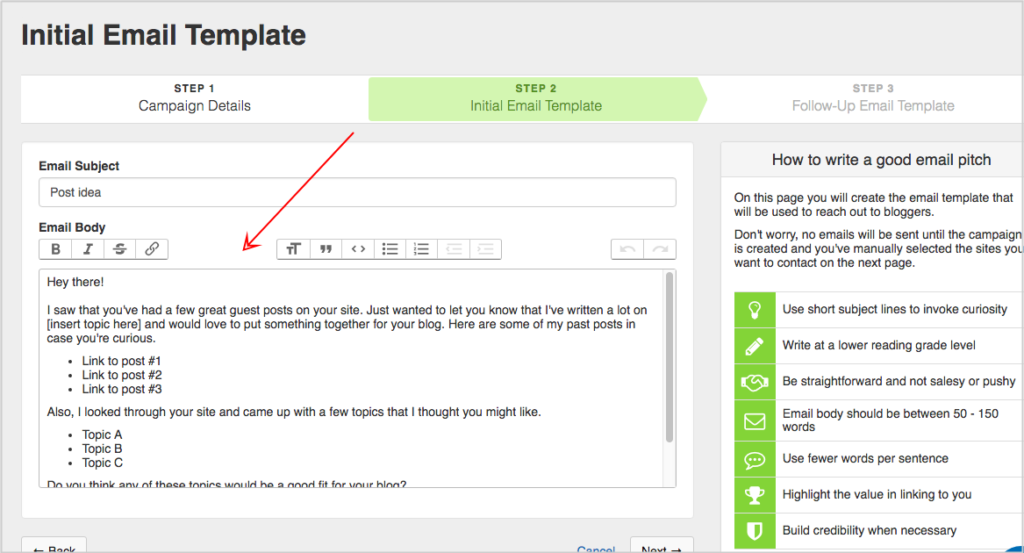
The link building tool also includes an option for follow-up emails (which can be automatically sent days after your initial emails have been sent).
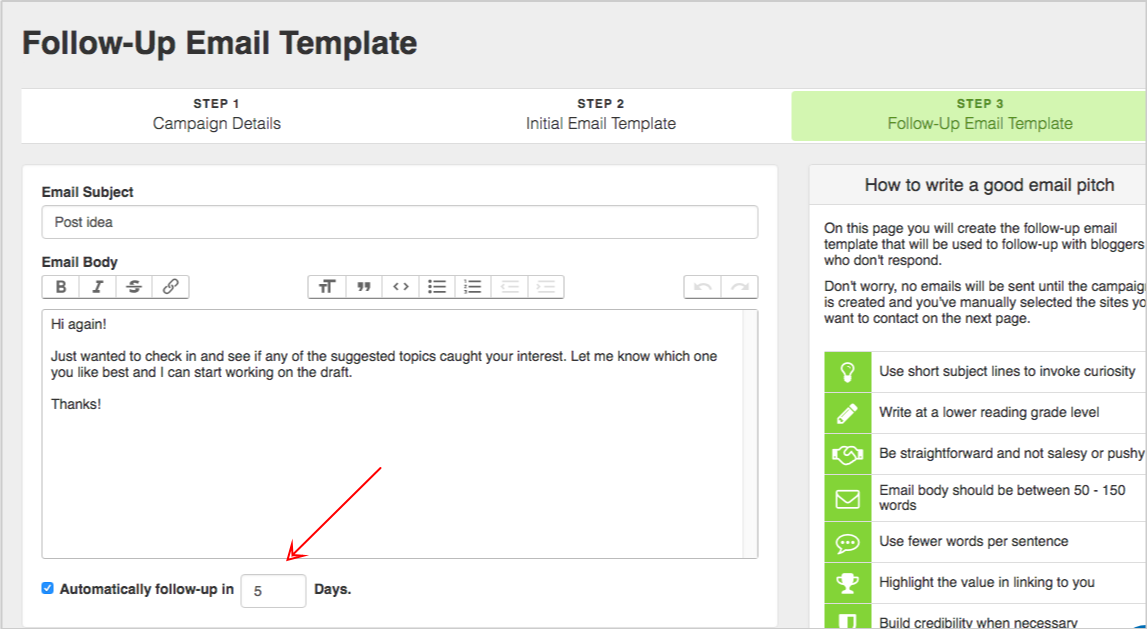
Pages automatically searched by the tool by using your target keywords and its default advanced search options for a specific campaign will now be ready to filter.
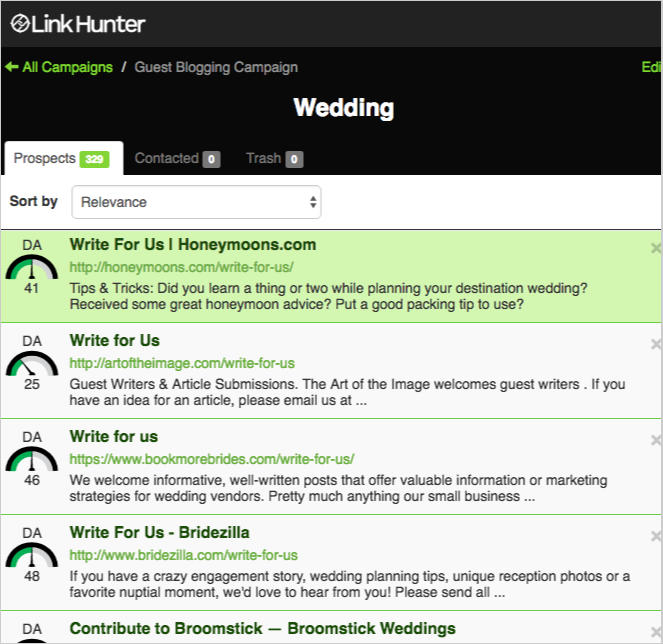
It has a sort option for relevance, domain authority and alphabetical.
Link qualification is critically important in executing a link building campaign, in that knowledge that you only choose the page that fits right for your campaign before you proceed to outreach.
LinkHunter gives you the opportunity to preview each page you want to qualify.
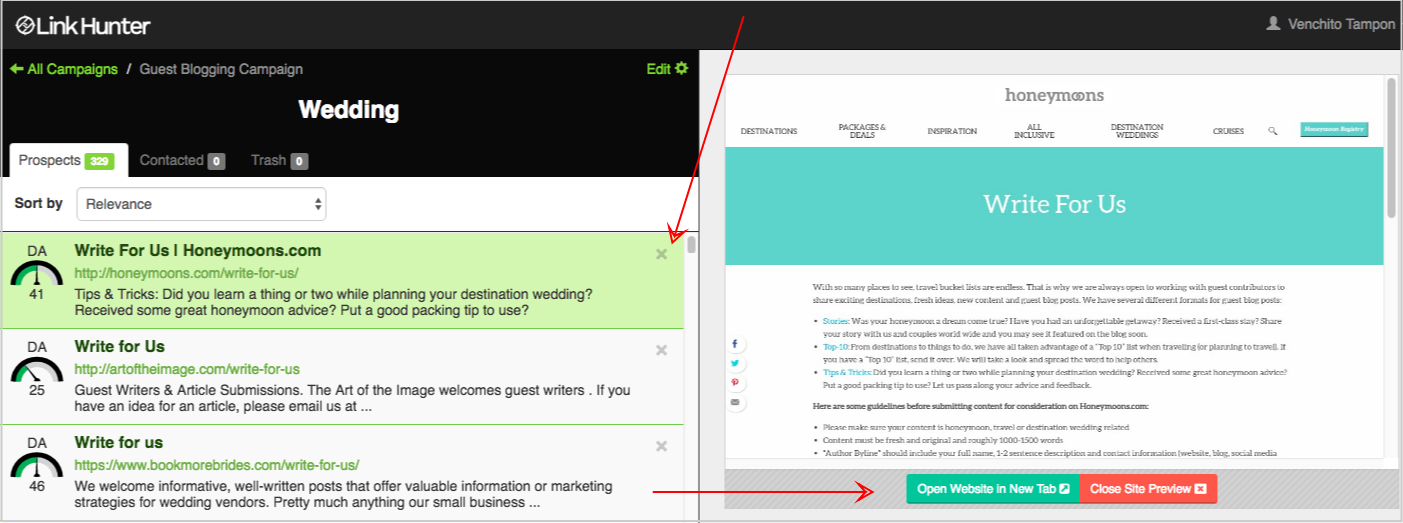
If you want to go directly to the website for further analysis, you can click the button "Open Website a New Tab".
One upside of LinkHunter is that it closes the gap between link qualification and outreach. You don't necessarily have to open a new outreach platform or your email account to send your pitches. You can go straight customizing each email at the right panel and send it right away.
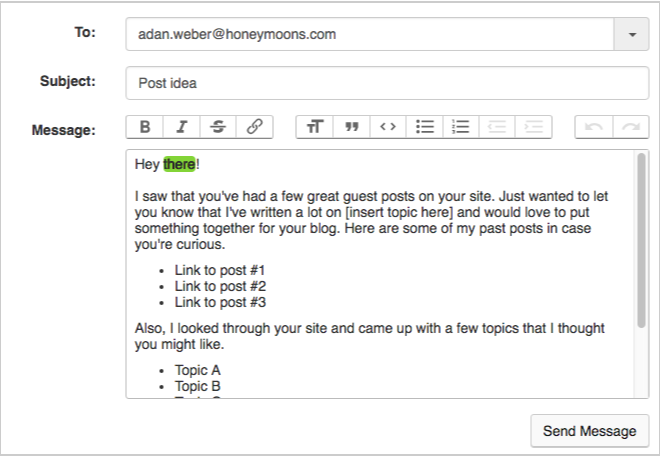
Pro tip: Choose the email that has high chances of responding to your pitch. For blogging campaigns, if there's no direct email contact person, you can choose editor@domain.com. Avoid reaching out to info@domain.com, sales@domain.com, support@domain.com and other departmentalized emails (your pitch might not be directly addressed by these departments).
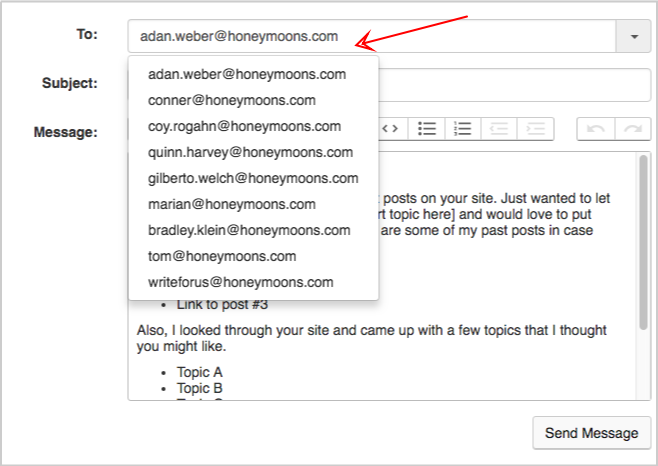
Every link building tool always has room for improvements. No exception with our product today.
What Needs Work
A few things to note, that when added as features of the product can make it more efficient to use:
1. No email scheduling - there is no option to schedules emails at later dates (both for initial emails and follow-ups). It is best to have automated follow-ups that can be sent as replies to the original emails than be sent as new emails.
2. No filtering capacity by relationship stages - there is no filtering option or list for relationship stages. There are visible stages from the campaign overview (prospects, contacted, responded and links), but there's no room to filter emails based on relationship stages.
3. Visible campaigns to certain people - campaigns are all visible to the person who logged into the tool. There are no options to make certain campaigns visible to assigned people only. I'm looking to avoid any errors committed, such as archiving campaigns by mistake.
4. Additional fields in templates - embedding images in email for creative email pitches and email signature.
5. Adding opportunities in bulk - lack of option to import a list of websites derived through other sources (competitor link research using link analysis tools or a list of link prospects through manual prospecting on search engines).
Overall, LinkHunter is best for a one-man link building team (who does every aspect of link acquisition) and small agencies who don't need to switch between link research and outreach campaigns. With further improvements, I think LinkHunter can be a highly efficient tool for link builders.
If you have questions and inquiries about this link building tool, leave a comment below.
Tactical Guide to Never Running Out of Link Prospects
Agility and efficiency are essential drivers of a successful link prospecting phase.
Setting a plan to never run of opportunities for link acquisition is important, since this can improve the entire campaign's prospecting rate as well as increase the average number of link prospects collected per hour/day.
By focusing on link prospect growth, link builders can expect significant improvements in the overall link development campaign, in parts such as:
- Enables to find new audiences targeted by new added link opportunities, which can be useful in brainstorming future content assets relevant to these audiences.
- Grows your current list of relationships with bloggers/webmasters/journalists (new connections can be derived by reaching out to additional list of link opportunities).
- Increases deliverables (# of links delivered on a monthly basis) for clients, since on a given average conversion rate, one can expect more links by sending more outreach emails to added link opportunities in the original list.

Here are 9 tactical methodologies to never run of opportunities for your link acquisition campaign.
1. USE "TOPIC" "GUIDE" TO SEARCH FOR CONTENT COMPETITORS
Reverse engineering has been a standard practice in link building - which is basically spying your competitors for link sources pointing to their pages.
However, that approach will leave you following the footprints of your competitors.
If you can be visible on websites they haven't acquired links from, it would be a better strategy to get ahead of them (or evenly outrank them!).
One initiative you can make is to look at other brands (not necessarily your direct competitors) that have published industry guides on similar topics.
We've found that using this search query, "GUIDE" "TOPIC" supplies a list of websites from other industries in SERPs that have topically-relevant content assets.
For example, a quick look for "veterans" "guide" can reveal this search result page.
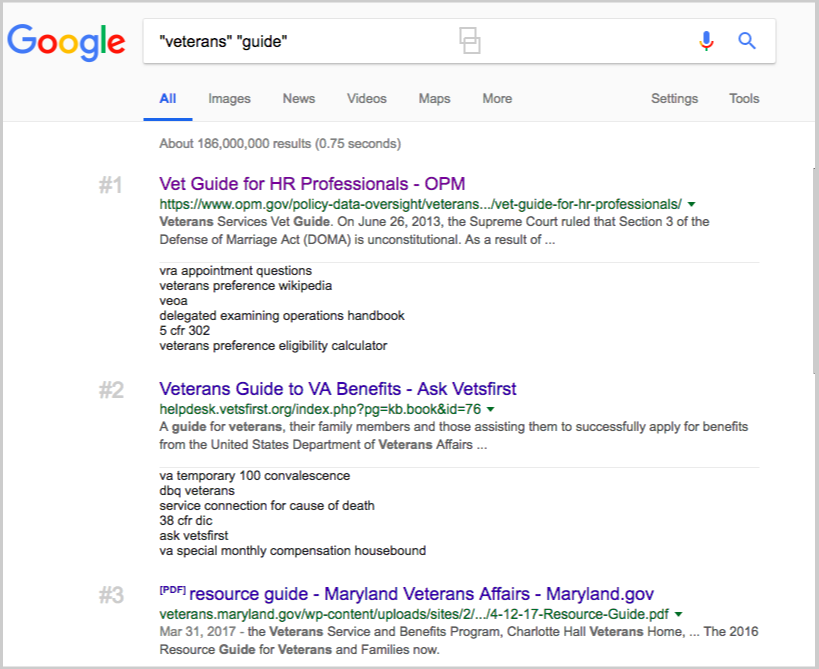
Your next step is to make a list of the people and sites/blogs who have linked to similar industry guides or have shared them via social media. You can extract these data using tools like Buzzsumo and Ahrefs.

It is best to list them down in a spreadsheet including each prospect's contact address.
Start reaching out to them. You'll have better chances of getting links given that they're interested about the subject of your content, since they've linked to a similar industry guide in the past.
2. KEEP TRACK OF WEBSITES WITH CONSISTENT LINKABLE CONTENT PRODUCTION
You will not always come across a brand that publishes a solid set of content assets while gets/attracts high-valued links to its pages.
If you have found a website that matches both of the above criteria, it's worthwhile to bookmark it and try to spy and assess their content strategy (both their content creation and promotion approaches).
In our broken link building campaigns, we've spot on and have kept track of all the websites that have continuously been producing heavy linkable assets in different industries.
Regardless of whether or not it is directly competing with our client, we monitor those sites for new content ideas and future linking opportunities.
For example, Affordable Colleges had been on my personal radar because they have been targeting new markets (audiences) through the new contents they published on their resource section.
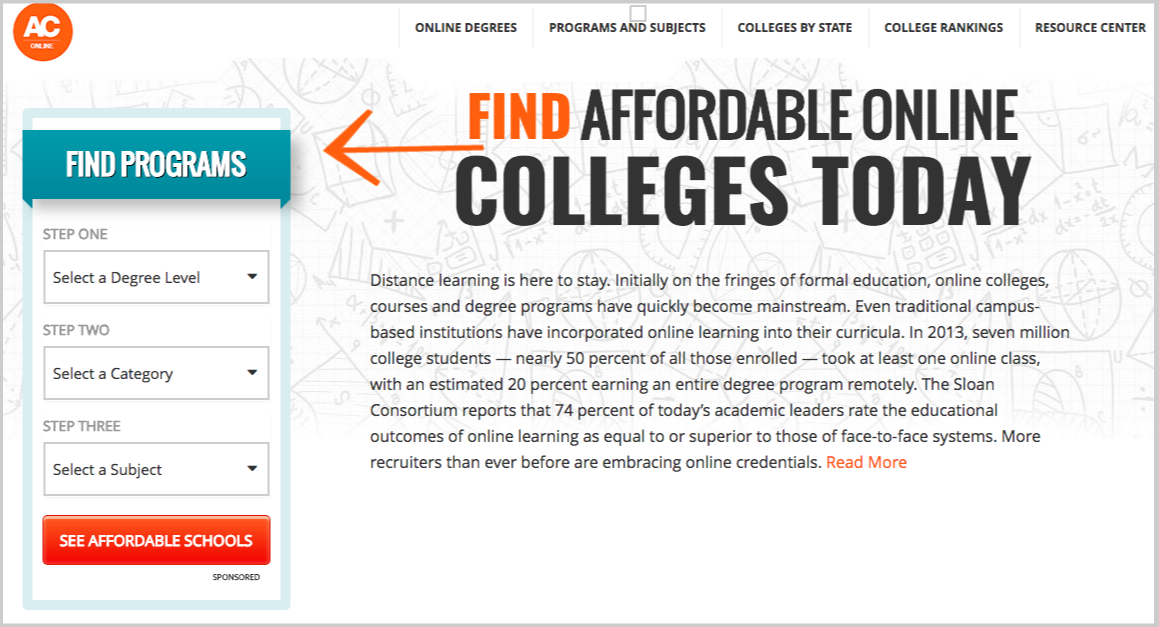
By using content analysis tools like Ahrefs, we can see their new industry guides they've invested heavily on content promotion (check Best by Links Growth feature).
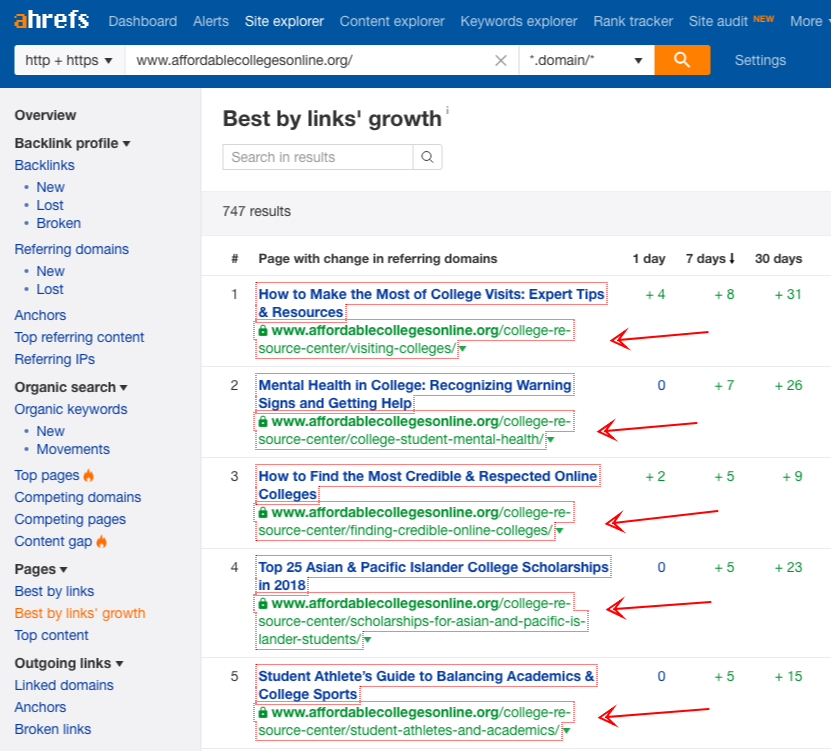
That approach can definitely expand opportunities for our future link development campaigns, given that we can tap into new markets that are not included in our initial list of linkable audiences, such as homeless students and multicultural & diversity groups.
3. INTEGRATE DEDICATED .EDU PAGES IN YOUR SEARCH QUERIES
Apparently, links from .edu pages is one type of links that can impact your pages' performance on search rankings and can really damage your industry's competition if you achieved success with it.
However, before getting results from any .edu link building strategies, you'll always start with .edu link prospecting - one that's hard to build when you're starting out.
One approach that you can use to scale .edu link prospecting is to target a specific type of .edu page in your search queries.
Those .edu websites normally have sections of information resources such as counseling, health & wellness, financial aid, community resources, and summer housing - which can be individually targeted in your search query depending on the subject of your page/site.
For instance, if you're in the mental health industry, one phrase you can include in search queries is "counseling" or "student health" to come up with the following targeted search queries:
- site:.edu "counseling" inurl:resources
- site:.edu "student health" inurl:resources
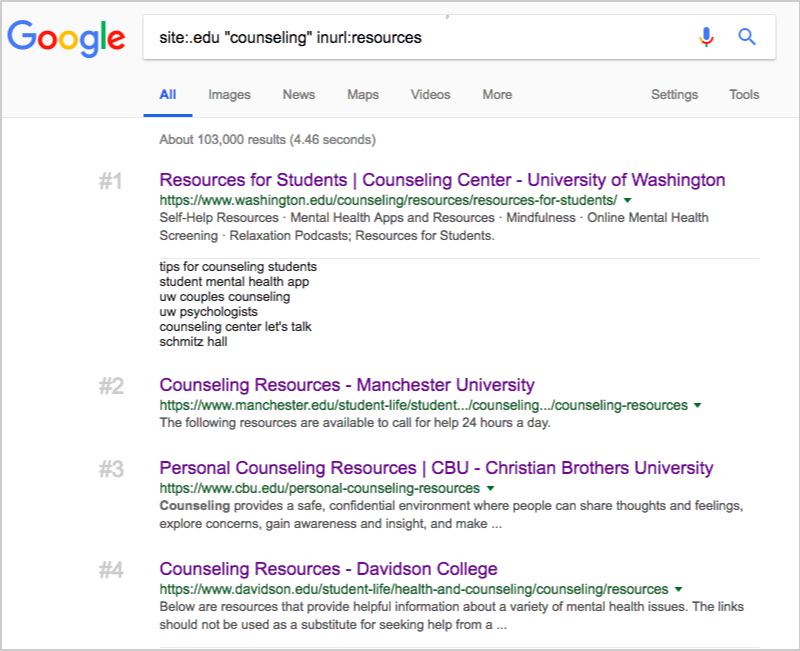
Here are more .edu pages for topical-relevant pages:
- "summer housing" - apartment categories
- "career & internship" - job sites, portals or resources
- "general health & wellness" - health organizations or niche-specific resource guides (e.g. sexual health)
Moreover, finding targeted pages of .edu sites can also be helpful with the kind of link building strategy you're currently using.
For example, when pursuing for scholarship links, instead of using the common search queries like (site:.edu "scholarships" "industry/topic"), you can be more targeted with your search by using the phrase, "financial aids" - which is a .edu resource page for students seeking for financial help.
4. START WITH LIBGUIDES QUERIES FOR .EDU LINK PROSPECTS
Another way to be proficient in high-authority link prospecting is to target libguides pages of .edu websites.
What exactly are libguides?
LibGuides are a content management and information sharing system designed specifically for libraries. The platform allows for easy navigation through and instruction on core and relevant resources in a particular subject field, class, or assignment.
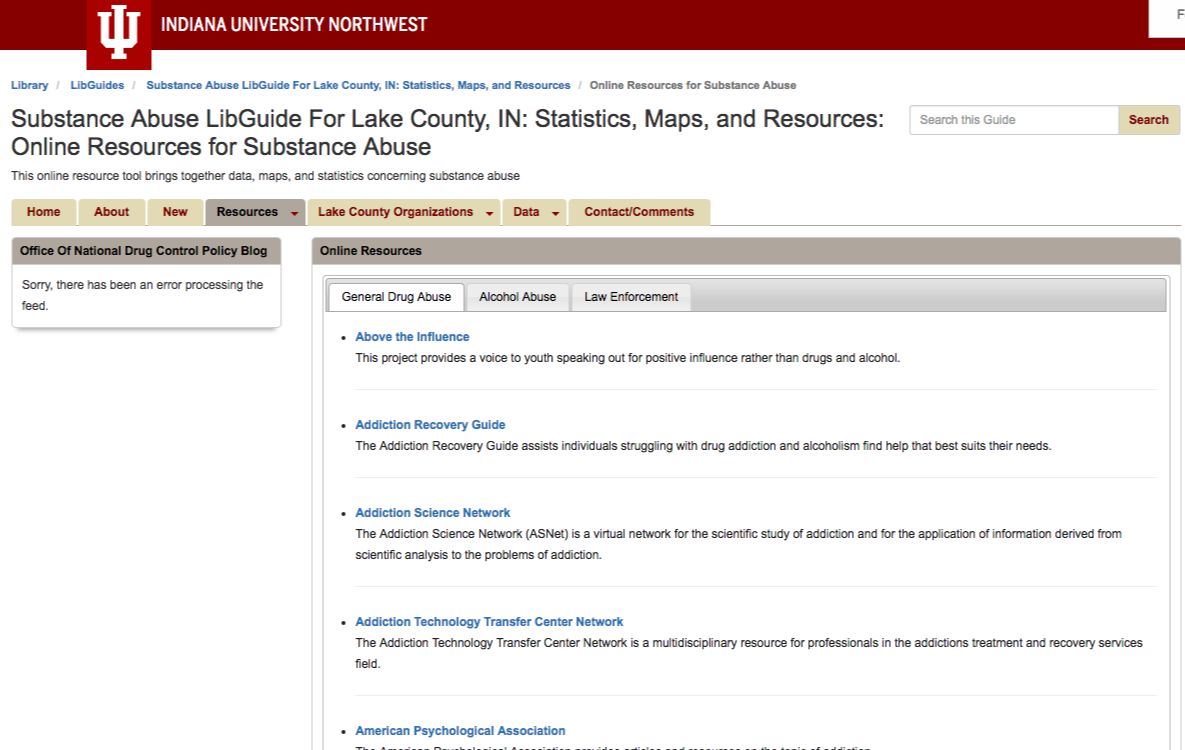
Libguides benefit students in many ways, such as:
- Allows students to focus on the relevant and sift out the less relevant.
- Visually demonstrates that there are great resources, in multiple formats, on even the most difficult topic. That reassurance builds the confidence of students who need to get started on their research.
You can see the other benefits of libguides to students here.
By definition and purpose, libguides are academic resource pages for students.
Given that they aren't updated that much, they usually contain broken links. Knowing that, you can use broken link building as an approach to acquire links from these high-value pages.
Resource page link building (or content suggestion) can also work as long as you have a high-utility content piece worthy of being referenced to by these academic pages.
How do you find these libguides?
You can do a Google search for inurl:libguide site:.edu "TOPIC" - replace the word topic with the subject of your content or website.

Before pitching to librarians (contact persons managing libguides) with a content published on your site/client, it is best to have a idea on what sorts of content, information, and content types that they prefer using as references.
Make sure you create the most comprehensive guide on the topic (or at least can match up to the resources that they've already linked to). If it's necessary to improve your content, do so to increase your chances of getting links from them.
5. SAVE LINK TARGETS OF LOWER METRICS
When prospecting for link opportunities, It's easy to overlook pages with lower metrics (i.e. <DA40), given that at the beginning of the campaign, link metrics has been set to use as a quality benchmark for all target pages/sites moving forward.
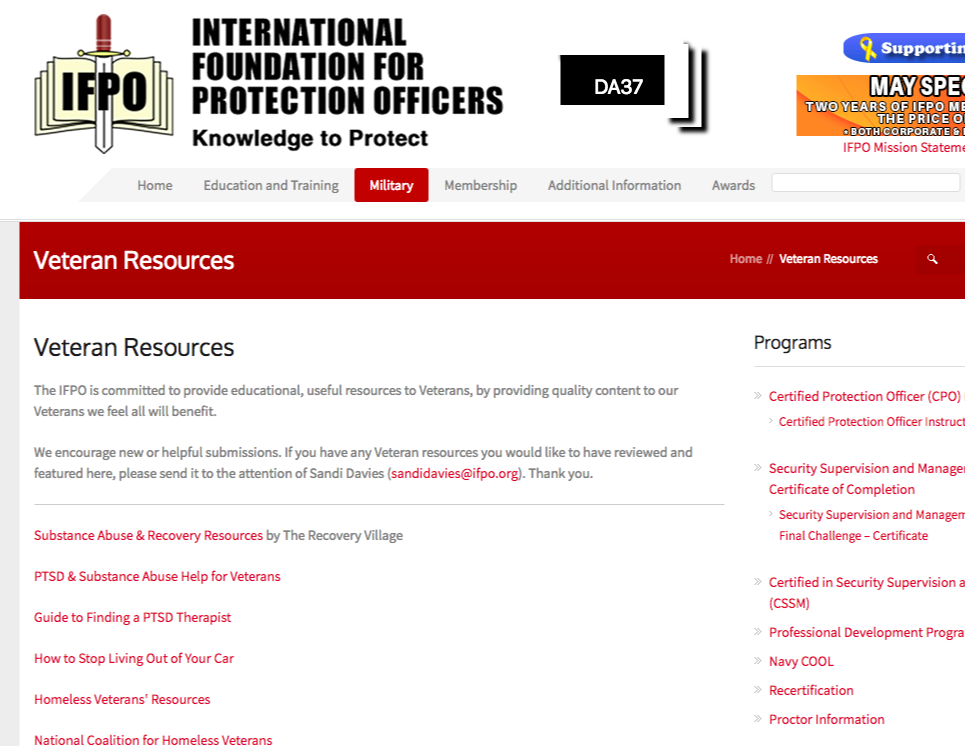
At SharpRocket, we've found that websites/blogs with lower metrics can be of highly useful for future campaigns. Some less authoritative websites can increase their organic traffic and earn/build links over time, which will eventually improve their entire domain authority.
Capitalize future equities of those neglected websites by making a separate list or spreadsheet to include them.
This is an approach not to run of our link prospects as you can return to your list over and over again, and find new ones that have improved its domain authority (or have passed to your benchmark metrics).
6. EXCHANGE CONTACTS WITH ACTIVE GUEST BLOGGERS
Building relationships with industry bloggers is vital not only when pitching them to become a guest contributor for their publications, but also in expanding your own list of link opportunities.
One approach that you can maximize in this situation is to pass on your contacts with them. Share your own lists of blogs that you have pursued for content contributions.
 It's a mutual benefit so you'll expect to get a fair share of lists from these active bloggers, too. It's worthwhile to do so given that their shared blogs have high response rates when you start emailing them.
It's a mutual benefit so you'll expect to get a fair share of lists from these active bloggers, too. It's worthwhile to do so given that their shared blogs have high response rates when you start emailing them.
7. REVERSE ENGINEER BROKEN PAGES FOR MORE LINK OPPORTUNITIES
A huge number of broken links on the web is the main backbone of broken link building.
Finding defunct links on a resource page and showing them to webmasters is one way to initiate conversations and eventually acquire links by suggesting link replacements (wherein one of the links is a link to the client's content piece).
The process ultimately starts with prospecting for relevant resource pages.
One prospecting methodology besides doing a Google search for common resource page queries - inurl:resources "topic;; inurl:links "topic" is finding other resource pages that are linking to broken links.
Start this process by finding broken URLs, which can be defunct links you've initially corrected in your first set of prospects (resource pages).
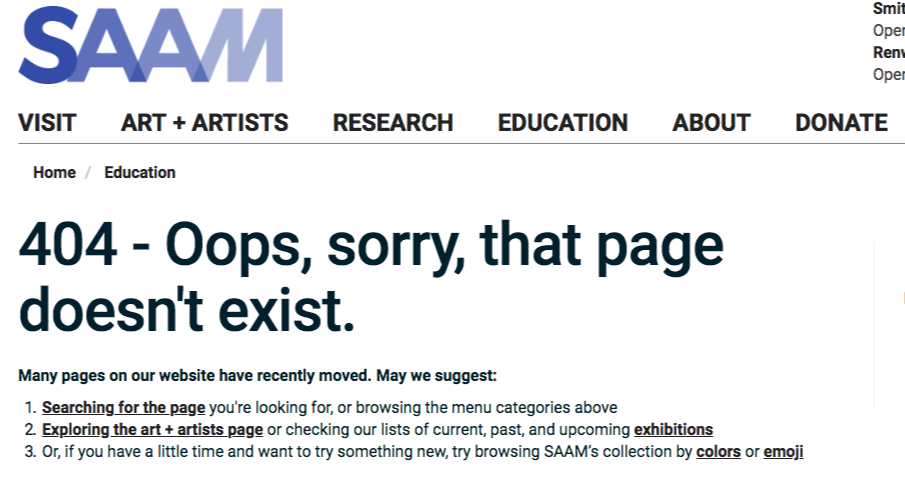 Check for any other websites linking to those broken URLs using any link tracking tools like Ahrefs.
Check for any other websites linking to those broken URLs using any link tracking tools like Ahrefs.

Create a spreadsheet to collect all websites linking to broken pages.
If you've found 20 broken links and have checked that there are around 300 total pages linking to them, your initial list has now grown to additional 300 prospects.
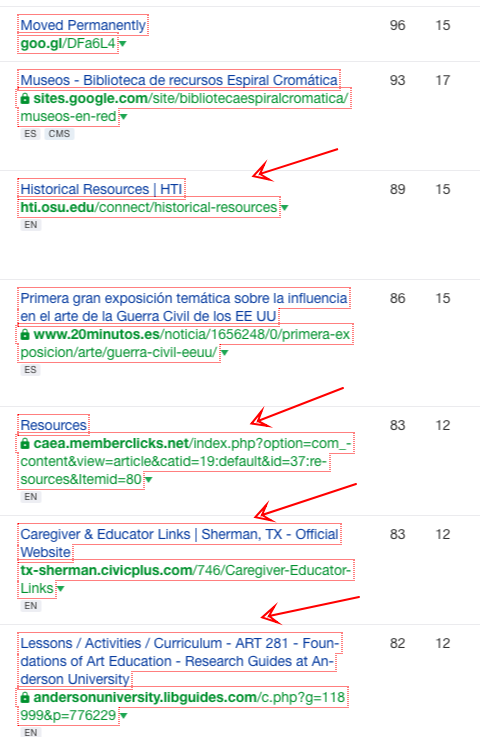
Of course, you have to quality these additional link targets by relevance, authority, and obtainability.
But overall, the said link prospecting (reverse engineering) methodology gives you room for more link opportunities.
8. CREATE NEW LISTS FOR NON-INTENDED AUDIENCES
One common mistake I've seen link builders do when prospecting link opportunities, specifically for resource pages, is ignoring current pages on their tabs as soon as they quickly find that these pages do not pass certain links' standards (e.g. irrelevant to their intended audience).
This tip is almost similar to the above prospecting principle (save prospects of lower metrics).
However, what I'd like to highlight in this last prospecting tip is saving prospects of different intended audience.
When you've landed on a page and found out that it's not relevant to your audience-targeting, you basically ignore it and move on to your next link prospect.
What I personally see a lot of value in seeking for more link opportunities (and for content generation, in general) is creating a new tab/list of other pages that don't fit to my current intended audience.
For example, when I'm looking for parenting-targeted resource pages and have come across pages that are targeted to non-intended audiences like LGBTQ, mental health enthusiasts, persons suffering from trauma, stress, and attempting suicide - I make new lists to collect them all.
This can somehow make it easier to find new audiences to target for future content assets.
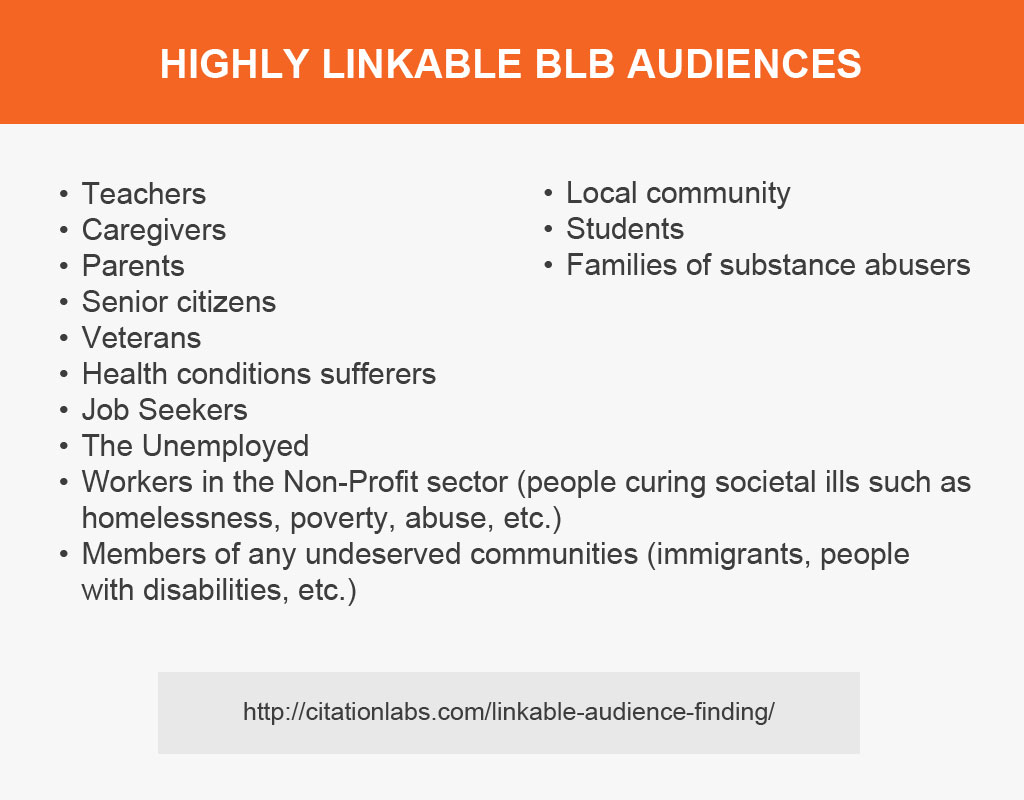
If you’re just starting in audience-first link building campaigns, you can start off with Garrett French's 601 Audience spreadsheet and basic linkable audiences as a base - and add more on to it along the way.
Liked this post? Subscribe to our newsletter and follow me on Twitter @venchito14.
Link Prospector: How to Get 3000 Prospects in 5 Minutes
In my work in SharpRocket, I often am asked what is the "best link prospecting tool" to scale link building campaigns for clients.
This post aims to answer that question.
Disclaimer: I'm not an affiliate of the tool that I'll be sharing with you - it's just that I highly recommend you try it out if you struggle with link prospecting.
There are only a few link builders that I respect in the industry because of their deep expertise and love for sharing insights that will best help the SEO community. Garrett French is one of them. He is the founder of Citation Labs, a link building agency and creator of Link Prospector Tool.
His tool can help semi-automate the search-query prospecting process that will definitely save hours of doing it manually.
Here's a walkthrough of how you can use Link Prospector.
If you already know how to use the tool, jump in straight to Feature Tips to get some goldmine tips.
Step 1: Create a Campaign
As soon as you sign up and login, you can start creating a campaign. I recommend that you name it after your Client or your Website so as not to get confused if you have several clients to work for in the future.
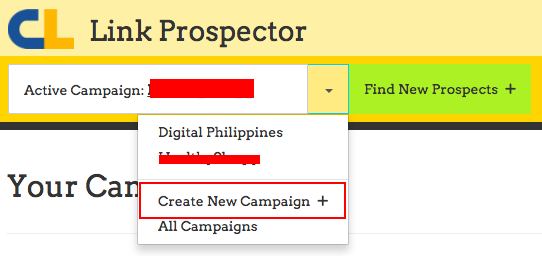
Step 2: Choose a Specific Link Type
Next is to start finding link prospects. Click on Find New Prospects in the Navigation bar.

Select the report type that suits your link building needs. For example, if you want resource or links pages, then choose links pages (pretty easy right?).
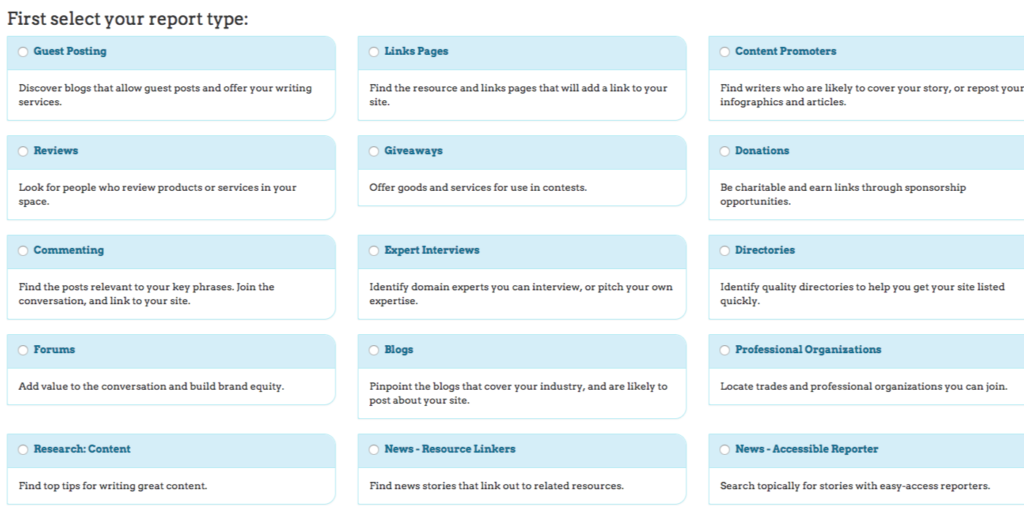
Click on Create Links Pages Report.

Step 3: Name Your Link Report and Set Advanced Options
I suggest naming your report under a niche such as snoring or flood planning. You can always go back to specific reports when you have another very specific client in the same industry or have a content asset on the same topic.
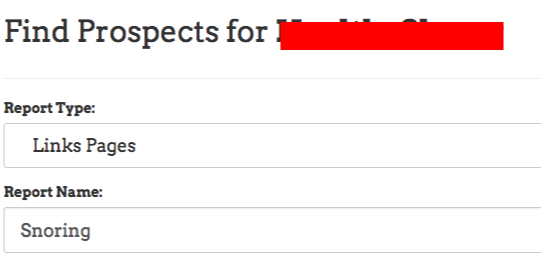
ADVANCED OPTIONS
If you want your link prospects to be very targeted, I suggest you choose customize search features on advanced settings.
Click on Show Advanced Options.

Let me pause a few seconds here.
You need to strategize your prospecting based on these options.

Let's check each one of them:
-
- Report Update Frequency - if you want your reports to be updated with new link prospects, you can choose update frequency as weekly, bi-weekly or monthly. But if you're doing an ad-hoc campaign, I suggest you choose Run Once.
- Language - don't change the default (English) unless you're tapping into Non-English markets.
- Select Region - choose the location you want searches to be queried from. This is best customized for country-specific link prospecting campaigns (e.g. tapping .co.uk backlink targets).
- Select Scope - leave it default if you're not targeting news pages.
- Select Depth - this allows you to choose how many results you want from each query. For example, if you type 4 custom queries and you choose a depth of 700, you'll get 2800 total results.
- TLD - choose the top level domains preferred for the results. They can be .edu, .gov, .org, .com, .us, .mil or other.
- Date Range - choose whether you want to get results from the past 24 hours, week, month or year.
- SafeSearch Filters
- Send Email Notification - choose whether you want to be sent the report to your email address or to another email address.
- Exclude Domains from - click or unclick Global Exclusions or Campaign Exclusions (more on this later).
- Research Phrases - include topical keywords to yield better search results. For more insights on non-SEO keywords, watch this video below:
Step 4: Start Prospecting and Wait For Your Report
When you have customize your report based on your needs in the advanced options and have included research phrases, the tool will give you its equivalent report cost, and show your available credits.
When you have decided your options are final, click on Start Prospecting.

Once you've submitted a report, wait for around 10 to 25 minutes for it to be ready. Do something else while waiting. The report will give you a number of results based on the number of research phrases and in-depth scope. For example, for 5 queries (research phrases) with 700 in-depth, it will give you 3500 prospects.
Here's what individual report will look like:
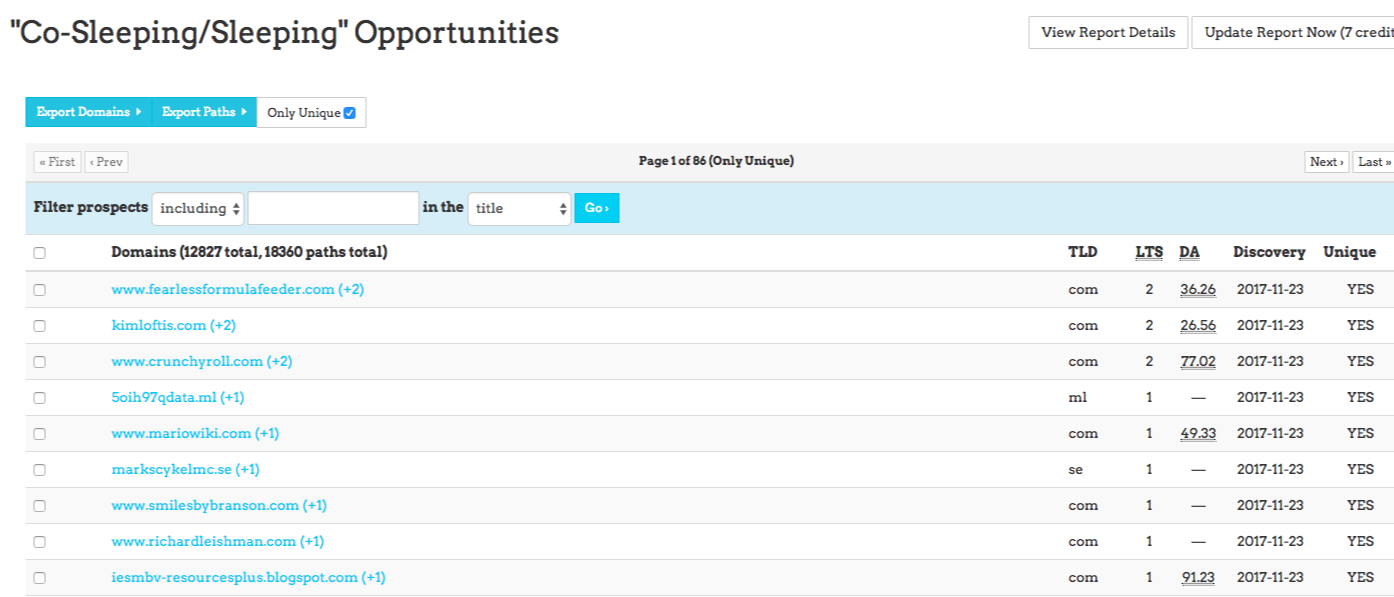
When you have run a few reports, your campaign page screen will look like this.

It shows you how many prospects you have for each report.
Step 5: Export Paths/Domains to Get Your Report
You'll see two options at the upper right side of your report screen, "Export Domain" and "Export Paths".
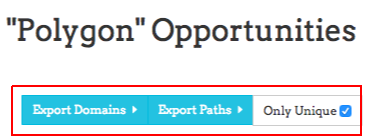
Export Domain feature gives you a list of the domains found in the report as a CSV file (e.g. sharprocket.com.ph) while Export Paths gets you a list of all the URL paths found in the report (e.g. sharprocket.com.ph/links-pages).
For each domain, there may be two or more URLs found that are queried based on your link types. See example below.
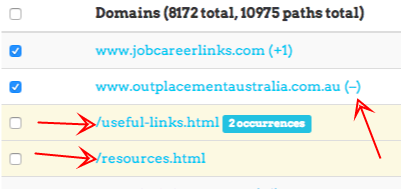
When you click on the number drop down, it shows you two URLs within the website.
I suggest you choose Export Paths for page-level link opportunities (resource pages, guest posts opportunities, sponsorships, etc..) and Export Domains for domain-level link targets that doesn't require you to target a specific page to get a link from (e.g. content promotion blogs).
Once you've exported URLs (for Export Paths), your CSV file when downloaded will look like this:
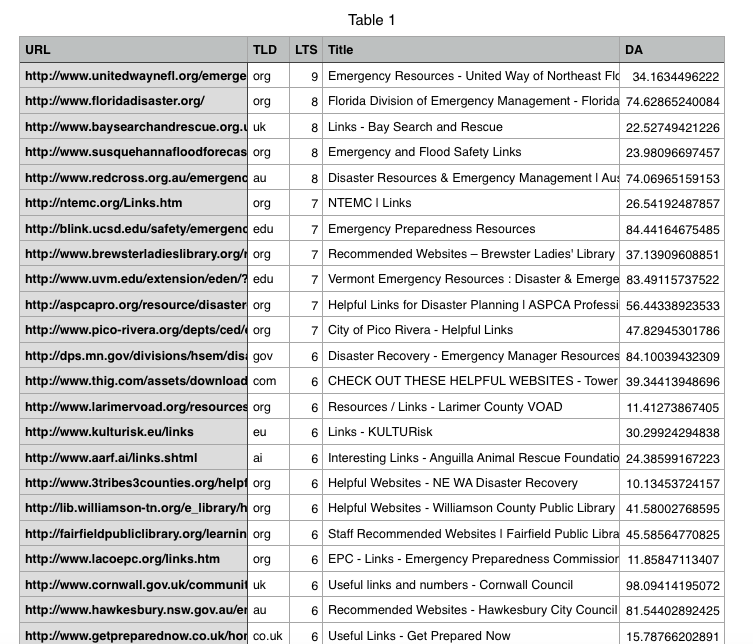
LINK PROSPECTOR FEATURE TIPS:
This section is to give you some tips on how to use Link Prospector more effectively helping you provide better targeted link opportunities.
The first tip is:
1. USE NON-SEO KEYWORDS AS RESEARCH PHRASES
If you have watched the video I've shared earlier, Garett French emphasized heavily about using non-SEO keywords or words as your research phrases in the tool. The reason is that the topical keywords can give you more page-level link opportunities, as they are more informational than commercial in nature.
One method that you can use is by doing a Google search for research phrases to check if they are more topical than commercial. If most webpages on the first page are commercial pages, you're less likely to get links.
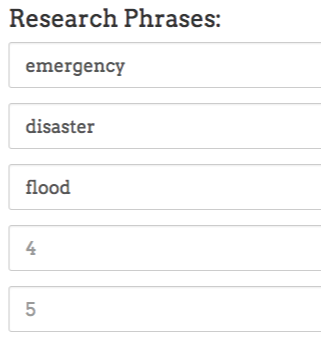
If you are struggling to add more research phrases, I recommend that you do a Google search for one topical phrase. And have a simple look at page titles and descriptions of URLs on the first page search results.
You'll then uncover phrases you haven't thought of relevant to your topical phrase that can be used as research phrases in Link Prospector.
Useful Resource: 4 Advanced Link Prospecting Techniques for Increased Efficiency
2. LEVERAGE .EDU AND .GOV TLD SEARCH FILTER
If you've been very specific with your prospecting, I recommend that you utilizeTLD advanced search option of Link Prospector.
For example, if you only want to find .edu and .gov links pages, it's better to choose .edu as your preferred TLD to filter results to only yield .edu link targets.

It's plain and simple.
3. MAXIMIZE GLOBAL OR CAMPAIGN EXCLUSIONS
Here's my recommendation:
Before you start creating a report, make a list of sites or pages you need to exclude from searching. These may include social sites like Pinterest, Facebook or Twitter or even the site of your client.
This aids you with the cleaning up process.
For campaign exclusions, I recommend that you get your list from backlink reports of your website generated from a link building tool like Ahrefs - the report is a list of links that you have acquired already for your website.
Make sure you exclude lost links in your campaign exclusions as you may still want to reacquire them in your outreach.
4. PROSPECT FAST BUT QUALIFY BETTER
The hard work isn't exerted in using the tool, but primarily on what you do after you have collected thousands of link opportunities in your hand - that is qualifying them.
Prospect fast but qualify better.
The tool gives you the edge of scalability. But the work doesn't stop there. You have to qualify each and every link target based on relevance Otherwise, it'll be difficult for you to acquire links from them (irrelevant to your niche) or most of your link opps will be too bad (not authoritative websites and spammy).
In addition, it's important to know the estimated number of quality link targets you can quality from a big report of links.
For example, in my list of 10,000+ unqualified pages, we've generated only 400 DA20+ niche-relevant link opportunities.
On average, we qualify 1000 prospects based on relevance and obtainability within 15 to 25 minutes. So the total time it took us to conduct relevance test for 10,000 pages was 2 1/2 hours to 5 hours.
That may be time-consuming to some of you, so I suggest that you hire a virtual assistant to do the task (a VA with basic skills charges $3 per hour).
With a good documentation/process (.doc) on how to quality each link opportunity, you can generate targeted possible links from thousands of unqualified ones.
5. PUT MORE EMPHASIS ON RELEVANCE THAN DA THRESHOLD
When qualifying link opportunities, some SEOs are heavy on DA numbers as their threshold. It's okay if you've got clients who look at and measure your deliverables based on that.
However, if you have the luxury to strategize on yo ur campaigns and its results, I suggest that you give more emphasis on relevance over DA because if not, you'll miss out on good opportunities.
Tip: Educate your clients regarding link metrics.
In conjunction to this topic, Jon Cooper killed it with his tweets:
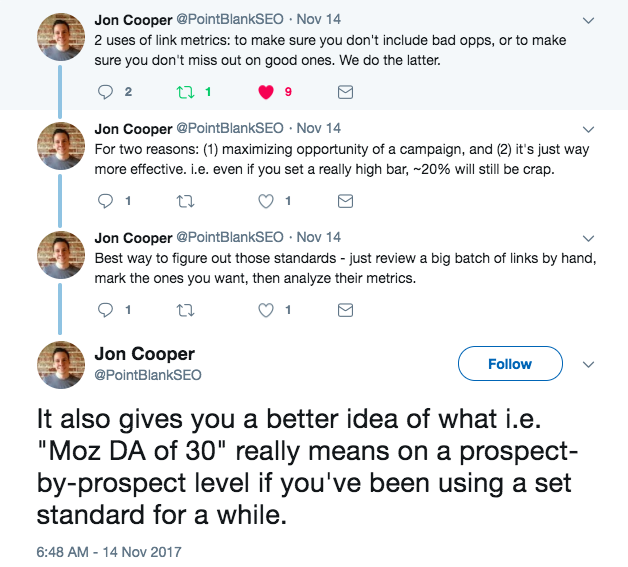
If you liked this post, subscribe to our newsletter and follow me on @venchito14.
Need help with your link building campaigns? Check out our link building services here.
4 Advanced Link Prospecting Techniques for Increased Efficiency
As I've come across several resource prospecting campaigns, I always notice little things that makes part of it more efficient. Efficient prospecting means producing a highly targeted output with the less amount of consumed resources (labor, time and cost of tools).
That itself requires experience through observation. So, here are four advanced prospecting techniques that hopefully can improve efficiency of your campaigns and help expand your list of link opportunities.
1. WEBSITE CATEGORIZATION
When starting a new outreach campaign for a client, the first initiative is to scour new link opportunities on the web from scratch. While this is good if it's a new industry you're taking on, isn't it wise to go back first to your previous list of industry-relevant opportunities and check which ones could be reuse for the new campaign?
Not only does it save time, it also saves a lot of labor consumption prospecting for links.
Website categorization does help with this. By using tags, you'll be able to categorize prospects from a topical perspective.
What you need here is a defined hierarchy of topics to begin with. For me, I recommend BOTW as starting point, given that they have four or five deeper-level topics such as Pro-Choice Abortion (Society) and Eating Disorders (Fitness) which is extremely important if you've got clients from a very-specific niche.
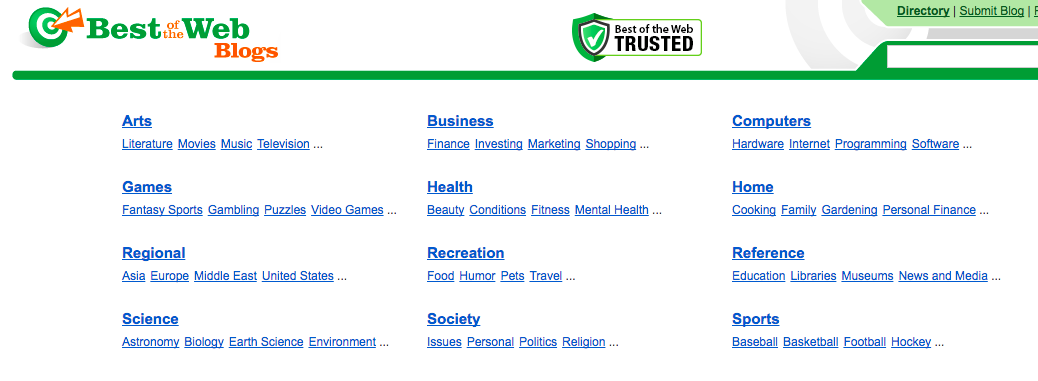 Make sure that your team agrees on certain topics to avoid any confusion when filtering your list. Having several but similar terms (i.e. I.T, Information Technology and Technology) as your tags is a trouble.
Make sure that your team agrees on certain topics to avoid any confusion when filtering your list. Having several but similar terms (i.e. I.T, Information Technology and Technology) as your tags is a trouble.
The next time you need automobile blogs, you can pull them off from a list within a few minutes.
2. CHECK DESCRIPTIONS IN LINKS TO EYE SEO'Y CONTENT
Backlink research is the process of identifying current and potential competitors and getting pages/sites that linked to them for link opportunities.
SEOs normally identify these competitors through Google search by checking which pages are currently ranking for target keywords or creating a list of competitors' sites coming from clients themselves (as they already have ideas which brands to compete with).
While these two approaches are best practices to find your most relevant competitors, you may still miss out some SEO'y content (as what Ross Hudgens coined it) that you should reverse engineer on.
SEO'y content are pages or content pieces already linked out from a resource page you're trying to reach out to, that have earned tons of links from several linking root domains.
Looking for SEO'y content can expand your vertical prospecting, either from a horizontal or vertical perspective, as they aren't easily found through Google search or normal prospecting.
One way to identify these SEO'y content is to check discrepancies in description of links. What I mean with discrepancies is that there are resource pages with full descriptions for each link and there are some with links with unusual descriptions.
I got this idea when I received a response from a webmaster putting a link to our client's page from their resource page.

If you skimmed the email above, you'll notice that there's nothing uncommon with the email, only does it implies that the webmaster is in a hurry not to include a description for our link - the reason she requested if we can create one for them.
Discrepancies in link descriptions—either the description is not complete or not in format with other link descriptions (see image below)—are signs that the resource page had recently given a link to an SEO'y content. TigerMobiles.com and US Dish links have Titles as their descriptions while other links have longer texts that describe what those pages are about.
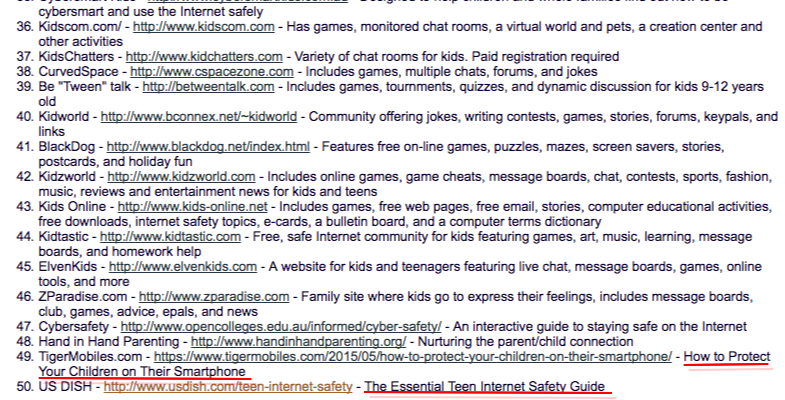
It means that these SEO'y content are actively pursuing relevant link opportunities (primarily resource pages) in the same manner that you do. If you could scour their existing links (some may have been recently just acquired), it will help you gain link targets that are receptive to content suggestions. Thus, giving you higher link acquisition rate in your outreach campaign.
Clicking on SEO'y content links and assessing if they have relevant links you can potentially use as link opportunities is a great activity you can add to your link prospecting process.
The best way I recommend to initially check if these SEO'y content has good number of linking root domains is to run them through LinkMiner.
The tool checks all external links on the resource page and highlights how many domains are linking to a certain external page.
3. USE LINKCLUMP TO UNOPEN DOCUMENT LINKS
In link prospecting, the more you spend time checking for unnecessary links, the more you waste time that should've been otherwise spent pursuing for the right link opportunities.
What I've noticed with newbie link builders is that they often click on document links (pdfs, words/spreadsheets ready to download, etc..) that are consuming seconds (if not minutes of their time) which are all useless if your main targets are links or resource pages.
The recommended approach is to use a tool that'll automatically unclick these document links once you start qualifying your list of link targets.
For example, if you have a list of pages ready to be qualified for certain metrics (DA, relevance, obtainability), copy and paste them in an opened tab tool (e.g. URLOpener.com).
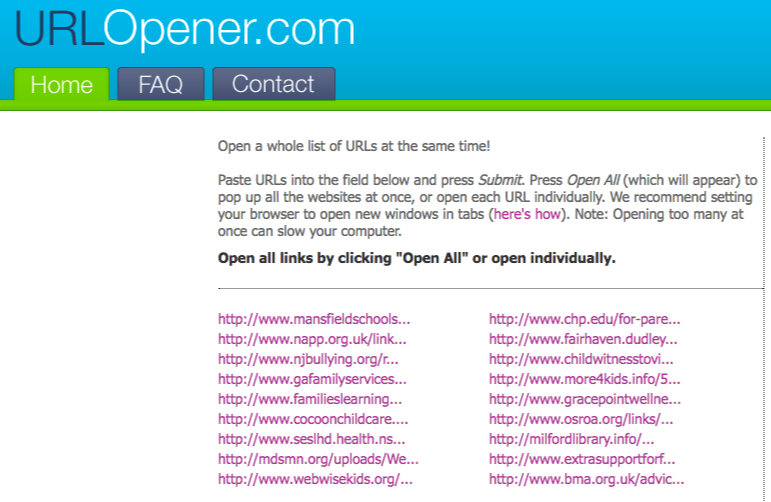 Then install Linkclump and use the filter option to add words that'll exclude links when it opens new tabs (pdf, doc, xls, etc..).
Then install Linkclump and use the filter option to add words that'll exclude links when it opens new tabs (pdf, doc, xls, etc..).
Once you right click and drag external links from URLOpener, the action itself won't open document links as new tabs given that you excluded certain words in the tool's setting.
4. UTILIZE NICHE PHRASES TO EXPAND LINK LIST
If you are familiar with your industry, it's easy for you to know what phrases are commonly used as titles in resource pages. For example, in the transportation industry, you'll see a lot of "getting there" pages. These are phrases that are only specific and be applied to a certain vertical.
But one question that may arise here is, what if it's a new niche I'm taking on, how can I identify niche phrases I can use for expanding my prospecting approach?
The best way to do that is to collect the titles of your first set of resource pages (I'd recommend that you get 80 or 100 links pages from your list for optimal results).
Use Wordcloud to see common niche phrases.
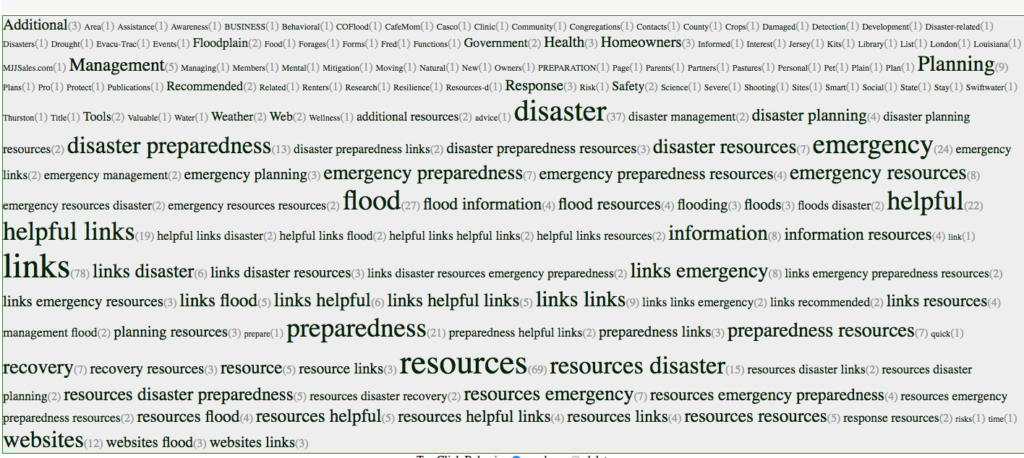
Ensure that you click phrases only and display frequencies checkbox. Phrases only feature does what you need from tool - to give exact niche phrases while display frequency shows you the number of times a phrase appeared in the list.

If you are clever enough about using niche phrases, your list of link opportunities will expand.
Other Useful Resources:
- 4 Reasons Why You Don't Get Resource Links
- How to Identify and Pursue Linkerati
- How to FuturePoof Your Links By Determining Lifetime Link Value
If you liked this post, subscribe to our newsletter and follow me on @venchito14.
Need help with your link building campaigns? Check out our link building services here.

